#so january poems at the top and december poems at the bottom
Explore tagged Tumblr posts
Text
My favorite poems of 2024
1. For Tess by Raymond Carver
2. Molly Brodak by Molly Brodak
3. Movement Song by Audre Lorde
4. White Egret by Chris Abani
5. The Two Voices by Alfred Lord Tennyson
6. I Am Waiting by Lawrence Ferlinghetti
7. To be Human is to Sing Your Own Song by Mary Oliver
8. Seeing through the Ground by Tomas Tranströmer
9. i dream on a crowded subway train with my eyes open but my body swaying by chen chen
10. Eurydice by H.D
11. A Walk in Tsaile by Jake Skeets
12. Watching you talk on the phone, I consider the empty space around atoms by Rhiannon McGavin
13. The Anactoria Poem by Sappho
14. jasper texas 1998 by Lucille Clifton
15. Cien Sonetos de Amor: XVII by Pablo Neruda
16. a good day by Kait Rokowski
17. Raising the Titanic by Robert Hedin
18. Anagrammer by Peter Pereira
19. Calling Things What They Are by Ada Limón
20. Poem With the Last Line as the First by Didi Jackson
21. The Gift by Li-Young Lee
22. Requiem for Toni Morrison by Harmony Holiday
23. Dead Rat by Mervyn Peake
24. Everything is Waiting for You by David Whyte
25. Tenderer than Tender by Osip Mandelstam
26. Darling Coffee by Meena Alexander
#i read over 80 poems in 2024#some of them i forgot to write down#but these are my favorites in no particular order#actually they’re ordered by when i read them#so january poems at the top and december poems at the bottom#a year in poetry#favorite
0 notes
Text

PROMPTING FOR HP TRIAD FEST 2024/25 IS OFFICIALLY OPEN!!!!
Finally, we are at the official start of this year's HP Triad Fest!!!
Prompting is open from DECEMBER 16TH - JANUARY 16TH.
✨THE PROMPTING FORM✨
Some prompting FAQs/need-to-knows:
How to prompt?
When you open the prompting form you will find the welcoming page so to leave your prompt click the [next] button at the bottom left corner. In the prompting form you can write which triad you want to see in the fic, the prompt the fic should be centred around, the maximum rating you wish the creator to follow for your prompt, as well as your likes and dislikes. At the top of the form there is an option for you to write your AO3 username as well, but you can totally keep your prompt anonymous.
How many prompts can I submit?
You can submit as many prompts as you wish! Just make sure that every prompt gets its own submission i.e. follow the instructions in the form where you will be given the choice to enter more prompts after you complete the form for the first time.
What types of fanworks are allowed? Can I make art?
Yes, go wild! We accept both written fanworks such as stories and poems, and visual fanworks too! Art, moodboards, edits—whatever your heart desires!
What is the 17+ rule?
For this fest we only accept ships and scenarios in which all characters in the main triad—and any side-ships which may appear—are over the age of 17 which is the age of majority in HP canon. No adult/minor pairings are allowed within the story. This rule also applies to any real-life people whose photos may be used in edits and moodboards! You can find more about this rule here.
Can I do a self-prompt?
Yes! BUT!!! We advise you not to prompt it during prompting because you will have the choice to self-prompt during the claiming. Of course, you can still do it now, but if you submit a prompt you wish to claim yourself through the prompting form we cannot guarantee that it will be available to claim for long as someone else might claim it before you. The safest option is to claim it through the claiming form so keep that self-prompt close to your chest until January 20th!
What if I have more questions or concerns?
You can send us an ask here on Tumblr, shoot us an email at [email protected] OR contact the mods on the Discord. We'll do our best to help you out!
Now that that's out of the way, I once again invite you to fill our prompt list to the brim! Lets give our creators so much inspiration they get dizzy!! As a reminder, prompting is open for one month - until January 16th 2025, so you have plenty of time to fill and submit that form again and again and again!
We wish you loads of inspiration and if you need some people to chat with while you get all your ideas straightened up: join our Discord! See you there and happy prompting season!
✨PROMPTING FORM✨
HP Triad Fest is an anonymous fest celebrating triads — romantic relationships between three equal parties of any gender, binary and sexuality — within the Harry Potter universe by inviting participants to create prompt-based fanworks centred around them! It's hosted on Archive of Our Own and supported via Tumblr and Discord.
#hp triad fest#hp triad fest 2024/2025#hp fest#harry potter fests#hp#harry potter#hp fests#poly triad#triad#hp triad#hp fandom#harry potter fandom#harry potter fest
19 notes
·
View notes
Text
Weather, Mountains, and Distance in China as Applied to the Módào Zǔshī Universe
I am a Foreign Teacher living in China and have been doing so for the last eight school years. For five and a half years I lived in Shandong Province, the same province as LanlingJin and I was a three and a half hour drive north of LanlingJin; a two to three-hour drive east and a bit south of LaolingQin; and a five to six-hour drive east and a bit north of QingheNie. For the last two and a half years I have lived in Jiangsu Province (barely) just two and a bit hours southwest of LanlingJin. But Jiangsu is the province of GusuLan and I am six hours north and a bit west of them; and not that anyone cares about MolingSu, but I’m four hours north and bit west of them. I have also travelled to every province, region, and territory that China says is China and most of those in January and February during Spring Festival Holiday. So from this experience I am going to discuss Chinese weather and a few other things that relate to the MDZS universe.
This ended up being way longer than I thought it was going to be. It was written to be read straight through. But as I’m pretty sure I’m the only one that cares and it goes through my thought process on the topic I have labelled each section so you can scroll down until you see the subheading you are interested in.
My Introduction to MDZS
My friend, told me about MDZS and the Untamed like 1 November 2019. I was at first skeptical as I have seen lots of Chinese shows playing in bars, at restaurants, or on long bus trips (the latter being where I’ve sort of had to see entire episodes and films) and generally Chinese TV shows are low on plot and have the same set character archetypes (not the point of this post so feel free to disagree, but I’m not here to argue). So honestly I was skeptical, but November is National Novel Writing Month, so even if I wanted to I hadn’t had the time. I also knew that I was going to be seeing said friend in Cambodia during Spring Festival Holiday and we would watch it then. Prior to going to Cambodia, I travelled with my Chinese friend Dean for eight days, but then he had to return home to spend Spring Festival with his family and I continued in my travelling.
I told Dean about how my friend was going to make me watch the Untamed and how it was based on a book and how it despite restrictions is still pretty gay. Dean didn’t believe me, but a couple days at home with nothing to do and plenty of wifi, and he had watched the Untamed before I could even meet up with my other friend!
Cloud Recesses in the Untamed - Mountains and Canal Cities
So that first scene where you see Cloud Recesses, I was like: oh I know those mountains! And my friend said that most of the places were really in China and sent me this map. As I continued watching well I was mostly caught up in the story but the snow kept bothering me, but there was never snow that stayed on the ground in the Untamed so I forgot it quickly. At a later rewatch I thought the Cloud Recesses mountains looked a lot like the mountains at ZhangJiaJie (the floating mountains that were the model for Avatar) in Hunan further west of where GusuLan is situated. According to the Untamed Wikipedia page the filming was done in Hengdian World Studios and Guizhou (also pretty far west). I am however a fan of climbing mountains and have climbed a lot of mountains in China, so I could be remembering mountains wrong.

Where the questions came up was fanfiction. And I have never stopped reading a fic because they talked about a lot more snow then I had ever seen in the particular area of China. And Cloud Recesses having towering mountains as they depict from afar in both the live action and the donghua. When I’m watching the mountain is a back drop, but often fics make the mountains or snow part of the plot and it’s too late because I already think of Gusu being Suzhou a very famous canal city south of me and we get like once a year two cm of snow that lasts maybe two hours. And the translator’s note at the end of Refinement Part 1 says that Cloud Recesses got its name from a phrase of Jia Dao’s poem, not the height of the mountains.
In general, I know that a lot of English fic writers just didn’t know the weather in China or perhaps hadn’t seen the map that showed you where everything in China was situated. And were using context clues like the disciples of YunmengJiang laying topless on floorboards in the summer heat in the extras from the book or the snow seen in both the Untamed and MDZS the donghua. And I had brushed it off as artistic license the height of the mountain of Cloud Recesses bugged me and made me do research for my own personal piece of mind.
I will admit I have not been to Suzhou, I skipped it when I was being a tourist in Jiangsu Province as the internet said it was a big tourist spot and could be very crowded, so I chose to go to a different canal town. Then I moved to Xuzhou in Jiangsu. And in Chinese the biggest thing is said first so I would have to say in Chinese when asked where I was moving to or later where I lived: Jiangsu, Xuzhou. The other thing I didn’t know despite having studied Chinese in college, that I learned from Dean when I complained about this problem is that all Yu (Yu, Yue, Yun, Yuan) and Xu (Xu, Xue, Xun, Xuan) no matter the tone are pronounced with a umlaut on the u so: Yü, Yüe, Yün, Yüan, Xü, Xüe, Xün, and Xüan. So, despite the fact that I pronouncing (disregarding tone for the following examples, and written by use of correlating English words and names) Xuzhou as Shoe-joe every Chinese person thought I said Suzhou (which I would say as Sue-joe). So, I heard a lot of: “Suzhou?! It’s so beautiful! And with all the water!” never anything about mountains.
Now, Guilin, Guangxi is a city that is absolutely gorgeous and has a lot of mountains, there is one called the Solitary Beauty Peak (152m), which is literally a vaguely rectangular mountain, with very sheer faces (and steep stairs carved in to get to the top), in the middle of a very flat expanse (behind the yellow building in the picture - January 2014).
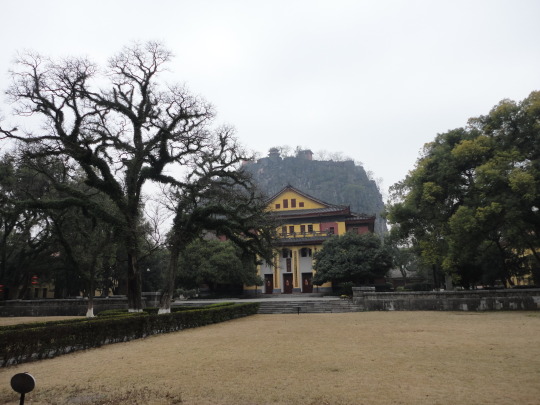
Which means that similar mountains could be in Suzhou. And Gusu was named after Gusu Mountain so I did an exhaustive search with multiple map apps, google, and baidu to find the mountains in Suzhou and their heights. In the end the mountains in Suzhou are not very tall.

Practical Experience with Snowfall in China
My first year in China my city got snow in December, maybe about 10 cms, but it was cold enough that it didn’t melt; and so we had snow for pretty much the whole winter with a sprinkling of a couple more cms added here and there. That year, I went to the Great Wall in the winter and signed up to go to Mutianyu a section of the wall pretty far from Beijing (north of all places in MDZS), but we couldn’t get to it due to snow, so we went to another section, Juyongguan, which wasn’t snowed out and it didn’t have too much snow on it maybe just a couple cms of snow built up in corners of steps and the like. That was the last time we really got snow that stayed. A few years later we got maybe a few cms but not a lot of snow. When I went to Sichuan (in 2014; where MeishanYu is) I remember leaving the Chengdu airport in a car and looking out the window to see snow dusted palm trees, something I had thought I really wouldn’t have ever seen, but that was probably the most snow that I had seen for that trip. The 12th edition of the China Lonely Planet book does state that the canals of Suzhou are very beautiful covered in snow in December. But based on how I’ve seen less snow further north than Suzhou makes me wonder how consistent it is.
Temperatures on Mountain Tops in China
I went to Ürümqi, Xinjiang the very tail end of June in 2019. July is the hottest time in Xinjiang and the temperature while I was there was generally about 30-45°C. One day I went to Tian Chi a lake in the Heavens Mountain (Tianshan) range, the lake is below the Peak of God (Bogeda Feng) that according to my Lonely Planet is a 5445m peak. Which now that I’m looking at the book, I know I hadn’t before going to Ürümqi, because the book says to bring warm clothing and I hadn’t. I took a tour bus up to the lake (I think that is the most common option. And around the lake it didn’t feel as hot as it was down in Ürümqi and when I went to take the cable car most of the way up Bogeda Feng, I remember seeing winter jackets for rent. At that moment I thought it was strange and pointless in the warmest time for the area despite that it was definitely getting chilly enough that I put on the light jacket (that prior to that point was mainly for sun protection) on. When I got out of the cable car near the top it was definitely cold. Many of the other hikers were in winter jackets and as you climbed up to the peak your breath definitely misted like it was winter! But that is the only time that has happened to me climbing mountains in China. I climbed Huangshan a mountain in Anhui, west and a bit south of Gusu. It has an elevation of 1873m and I climbed it in May, and there was no discernible temperature difference between the top and the bottom of the mountain.
The Yangtze River – divider of whether your home is heated or not
The Yangtze River is what China uses as a divider of north and south China. In the present day this is seen as whether or not your home gets central heating in the winter. When I lived in Shandong province (north of the Yangtze), the central heating was turned on 1 November and turned off the 1 March (I think, I’m remembering that correctly). Each province decides how cold it is and for how long and has different rules for central heating. No matter what you don’t have control over the temperature of the central heating, and everyone has to survive with an AC/Heating mounted wall unit, and/or portable heaters.
Jiangsu is a province that the Yangtze cuts through, which means you might get central heating. I moved to Xuzhou, which is spitting distance to Shandong province, in May (I got transferred to cover a sick teacher). So I was put up in the teacher’s housing on the college campus, and it did have central heating, the flat also had screened in windows above the doors that didn’t have glass and therefore would be open year-round. When I said I wanted to stay in the city and teach for the next year I got an off-campus flat in a community maybe 1.5 kms down the road—no central heating. Fall 2019 my community was offered central heating, we would have had to pay to get it installed, and it would only be installed if enough people said yes because it would be done for the whole community at that point. If we got the central heating it would have only been turned on December-February, and as the Spring Festival break at the school was an entire month it wasn’t worth it. And that time I went to Sichuan (everyone says south, but I think it has a bit of the Yangtze in it) all the restaurants were open fronted with no solid doors at all. Though the AC/Heating mounted wall unit in my hotel room (a small hotel outside of the city proper with a squat toilet in the bathroom (I’ve only seen squat toilets in two Chinese hotels)) was the best heater ever. My hotel room was so much warmer than any flat I’ve had in China, because even if it was a cheap hotel the AC/Heating mounted wall units needed to work well in Sichuan because it was the only source of heat.
MDZS Cities on the Yangtze and Old Names for the River
So west to east the cities that are close/on the Yangtze are: Meishan - north, Kuizhou - north bank, Yiling - north bank, Baling - south bank, Yunmeng - north, Moling south (the Yangtze goes through Nanjing so maybe it has bank space), and Gusu - south (possibly in the delta).
According to the Yangtze Wikipedia Page, which I have kept open in a tab in Firefox for reference since I started writing fic—People in Ancient China didn’t realise that the river was a single river and therefore each section of the river, had its own name and was thought to be its own river (the following is mostly just copied from Wikipedia).
For Meishan, Kuizhou, and Yiling, the river through Sichuan and Chongqing Municipality was known as the Chuan Jiang (川江; Chuān Jiāng) or "Sichuan River." The Wikipedia page specifically states that Yichang modern day Yiling as the last/most eastern city to call the Yangtze thus.
In Hubei, this would be Yunmeng and Yiling, but Yiling followed the pattern of the places further west. And I’m going to assume Baling despite being in Hunan; the river is also called the Jing Jiang (荆江; Jīngjiāng) or the "Jing River" after Jingzhou.
In Anhui (which has no sects), the river takes on the local name Wan Jiang after the shorthand name for Anhui, wǎn (皖).
For Gusu and Moling, it was the Yangzi Jiang (揚子江; 扬子江; Yángzǐjiāng) or the "Yangzi River," from which the English name Yangtze is derived, is the local name for the Lower Yangtze in the region of Yangzhou. The name likely comes from an ancient ferry crossing called Yangzi or Yangzijin (揚子 / 揚子津; Yángzǐ / Yángzǐjīn). Europeans who arrived in the Yangtze River Delta region applied this local name to the whole river.
The dividing site between upstream and midstream is considered to be at Yichang (Yiling) and that between midstream and downstream at Hukou (Jiujiang).
Winter Weather in Terms of Whether or Not Long Underwear Should be Worn in Various MDZS Cities
Another way to think of it is in terms of long underwear. I wore long underwear in my city in Shandong province, the pants, and a long undershirt. Typically, three layers on top when indoors, maybe with a fourth sweater when the room I was in wasn’t heated and thick socks over regular ones. In Xuzhou I wore maybe the long underwear bottoms but not the top because my classroom actually has a heater in it, but I usually wore a sweater. When I visited Xi’an, Shaanxi (YueyangChang and 2hrs west of QishanWen), Nanjing, Jiangsu (MolingSu), and when I went to Chengdu, Sichuan (1.5 hours north of Meishan) I wore long underwear (though it was particularly cold that year in Chengdu). When I went to Hangzhou, Zhejiang (south of TingshanHe; Tingshan is hard to pinpoint), Changsha, Hunan (2 hours south of BalingOuyang), and Wuhan, Hubei (3 hrs north of BalingOuyang and 1.25 hours south of YunmengJiang) I had long underwear with me but didn’t necessarily wear it. I do remember in Wuhan this tree that had little pink blooms on it at the end of January. I didn’t have long underwear with me when I went to Chongqing, I could have sworn I actually went to Kuizhou Ancient City (or another Ancient City/Street) but I can’t find pictures from it. The city I visited before Chongqing, I visited an ancient city so I could be mixing these up. But I remember it being Chongqing and getting a foot massage in an open-air shop in an ancient street and being covered in blankets because it was pretty chilly.
Comparative Temperatures based on their North Parallels
I live in Maine in the US, so a place with lots of snow. When I first came to China my family and I were looking at the map and thought that Maine and my city in Shandong looked to be in a line so the weather would be similar—it wasn’t, but it is a good theory; and something I spent a lot of time thinking might be sound as Maine and Shandong province aren’t on the same parallels so I thought there was still a chance that it would correlate elsewhere. The two most northern sects QingheNie at 37°04’ and LaolingQin 37°26’, according to Wikipedia, which continues to tell me that other notable places on the 37th parallel. The 37th parallel separates out Utah, Colorado, and Kansas on the north side from Arizona, New Mexico, and Oklahoma on the South. It also passes through the Mediterranean Sea; the Aegean Sea; the Caspian Sea; the Sea of Japan; the Yellow Sea; just south of Antequera, Spain; the island of Sicily, Italy; the island of Honshū, Japan; Gilgit-Baltistan, Pakistan/India; and through Algeria, Tunisia, Turkey, Iraq, Iran, Turkmenistan, Afghanistan, Tajikistan, and South Korea.
I just moved to Zhengzhou, Henan (34°45′50″N), when I asked about the weather I was told it was comparable to Washington DC (38°54′17″N). I keep getting told that Zhengzhou is the centre of China and it is kind of the centre of where all the sects are: north 1.5 hours from YingchuanWang and 5.5 hours from YunmengJiang; south 3.5 hours from QingheNie; and east 6 hours from YueyangChan.
Conclusion for Winter Weather in Gusu and Summary of Chinese Summers
So, based on my experiences, any of the mountains in Suzhou just wouldn’t have a discernible temperature difference from the top of the mountain and the bottom of the mountain. And despite “Snow-covered views of the pretty canal towns of Suzhou in winter” I would assume that it doesn’t actually get that much snow.
So enough about how cold and snowy China is, summer-wise it is generally too, too hot. For the level of cold in the winter, I would have assumed there would be milder summers but where I have lived and visited that has not been the case. When I asked the teacher I was replacing in Shandong about the weather of the city I was told that it went from ‘freezing your pants off to fucking hot’ and it was true one day you’d be wearing a jacket and maybe for a week you’d be in jeans and a tee and then you’d be sweating while wearing the least amount of clothing possible. I’ve definitely seen 30°C days in May.
Rundown of the Climate, Average Temperatures, Rainfall, and Humidity for all MDZS Cities
So you don’t have to here is what Wikipedia says about the climate of the cities of the different areas so you don’t have to look it up yourselves (pretty much copy and pasted):
Baling – (is present day Yueyang different characters and city from the YueyangChang Sect seat). The average high for the year is 21°C/69.7°F and the low 14.9°C/58.8°F. January being the coldest month with an average low of 2.7°C/36.7°F and an average high of 8.1°C/46.6°F. July is the hottest month with an average low of 26.6°C/79.9°F and an average high of 32.2°C/90°F. Average humidity ranges from 73% in December to 79% in June (with a yearly average of 77%). The most average rainfall is in June, the rain heavy months being April-July, compared to the remaining months March and August also have a lot of rain.
Gusu - has a four-season humid subtropical climate with hot, humid summers and cool, cloudy, damp winters with occasional snowfall (Köppen climate classification Cfa). North-westerly winds blowing from Siberia during winter can cause temperatures to fall below freezing at night, while southerly or south-westerly winds during the summer can push temperatures above 35 °C (95 °F). The average high for the year is 19.9°C/67.8°F and the low 12.5°C/54.5°F. January being the coldest month with an average low of 0.5°C/32.9°F and an average high of 7.7°C/45.9°F. July is the hottest month (by 0.1°C over August) with an average low of 24.8°C/76.6°F and an average high of 31.6°C/88.9°F. Average humidity ranges from 65% in November to 77% in July (with a yearly average of 71%). The most average rainfall is in September, the rain heavy months being June-September, April (102.3 mm) and May (114.5) are petty rainy too, May is still 14mm less rain then July (the lowest of the high rain months).
Kuizhou - has a humid subtropical climate (Köppen Cfa), bordering on a monsoonal humid subtropical climate (Köppen Cwa) and for most of the year experiences very high relative humidity, with all months above 75%. Known as one of the "Three Furnaces" of the Yangtze river, its summers are long and among the hottest and most humid in China, with highs of 33 to 34 °C (91 to 93 °F) in July and August in the urban area.Winters are short and somewhat mild, but damp and overcast. The city's location in the Sichuan Basin causes it to have one of the lowest annual sunshine totals nationally. With over 100 days of fog per year, is known as the "Fog City" The average high for the year is 22.1°C/71.8°F and the low 15.8°C/60.4°F. January being the coldest month with an average low of 6.2°C/43.2°F and an average high of 10.3°C/50.5°F. August is the hottest month (by 0.2°C over July) with an average low of 24.7°C/76.5°F and an average high of 33.2°C/91.8°F. The most average rainfall is in June, the rain heavy months being June and July, but May and August are petty rainy too.
Lanling - has a monsoon-influenced climate with generous summer precipitation, cold, dry winters, and hot, humid summers. Under the Köppen climate classification, it is in the transition from the humid subtropical zone (Cwa) to the humid continental zone (Dwa), though favouring the former. More than half of the annual precipitation of 833 mm (32.8 in) falls in July and August alone, and the frost-free period is above 200 days. The average high for the year is 19.1°C/66.3°F and the low 9.5°C/49.1°F. January being the coldest month with an average low of -4.3°C/24.3°F and an average high of 4.4°C/39.9°F. July is the hottest month (by 0.7°C over August) with an average low of 23°C/73.4°F and an average high of 30.7°C/87.3°F
Laoling - The average high for the year is 19.3°C/66.7°F and the low 9.4°C/48.9°F. January being the coldest month with an average low of -5.6°C/21.9°F and an average high of 3.4°C/38.1°F. June is the hottest month with an average low of 20.2°C/68.4°F and an average high of 32.1°C/89.8°F. Average humidity ranges from 52% in March to 78% in August (with a yearly average of 63%). The most average rainfall is in July, the rain heavy months being July and August by quite a margin. July has on average 90 mm more rain then June (the month with the third highest rainfall).
Meishan - The average high for the year is 21.3°C/70.3°F and the low 14.3°C/57.7°F. January being the coldest month with an average low of 4.1°C/39.4°F and an average high of 10.1°C/50.2°F. July is the hottest month (though the record high temperature was in August) with an average low of 22.9°C/73.2°F and an average high of 30.7°C/86.5°F. Average humidity ranges from 74% in May to 84% in January, August, October, and December (with a yearly average of 81%). The most average rainfall is in August, the rain heavy months being July and August, June (144 mm) and September (130.4) are petty rainy too, June is still 87mm less rainy then July (the lowest of the high rain months) and September gets 42.5mm more rain than the 5th rainiest month—May.
Moling - has a humid subtropical climate (Köppen Cfa) and is influenced by the East Asian monsoon. The four seasons are distinct, with damp conditions seen throughout the year, very hot and muggy summers, cold, damp winters, and in between, spring and autumn are of reasonable length. Known as one of the "Three Furnaces" along the Yangtze River for the perennially high temperatures in the summertime. However, the time from mid-June to the end of July is the plum blossom blooming season in which the meiyu (rainy season of East Asia; literally "plum rain") occurs, during which the city experiences a period of mild rain as well as dampness. Typhoons are uncommon but possible in the late stages of summer and early part of autumn. The annual mean temperature is around 15.91 °C (60.6 °F), with the monthly 24-hour average temperature ranging from 2.7 °C (36.9 °F) in January to 28.1 °C (82.6 °F) in July. Extremes since 1951 have ranged from −14.0 °C (7 °F) on 6 January 1955 to 40.7 °C (105 °F) on 22 August 1959. The average high for the year is 20.6°C/69.1°F and the low 12.1°C/53.8°F. January being the coldest month with an average low of -0.7°C/30.7°F and an average high of 7.2°C/45°F. July is the hottest month with an average low of 24.9°C/76.8°F and an average high of 32.2°C/90°F. On average precipitation falls 115 days out of the year, and the average annual rainfall is 1,090 mm (43 in). The most average rainfall is in July, the rain heavy months being June through August. August (143.5mm) is the least rainy of the three and still gets on average 52.8 mm more rain then May the 4th rainiest month. July has the most days of rain (12.3), but both March (only 80.4mm) and August have the second most days of rain (11.8).With monthly percent possible sunshine ranging from 37 percent in March to 52 percent in August, the city receives 1,926 hours of bright sunshine annually. Average humidity ranges from 71% in April and May to 80% in July and August (with a yearly average of 75%).
Qinghe - has a continental, monsoon-influenced semi-arid climate (Köppen BSk), characterised by hot, humid summers due to the East Asian monsoon, and generally cold, windy, very dry winters that reflect the influence of the vast Siberian anticyclone. Spring can bear witness to sandstorms blowing in from the Mongolian steppe, accompanied by rapidly warming, but generally dry, conditions. Autumn is similar to spring in temperature and lack of rainfall. The annual rainfall, more than half of which falls in July and August alone, is highly variable and not reliable. The average high for the year is 19.6°C/67.2°F and the low 8.8°C/47.9°F. January being the coldest month with an average low of -6.1°C/21°F and an average high of 3.9°C/39°F. June is the hottest month with an average low of 20.2°C/68.4°F and an average high of 32.1°C/89.8°F
Qishan - The average high for the year is 18.5°C/65.3°F and the low 9°C/48.1°F. January being the coldest month with an average low of -3.5°C/25.7°F and an average high of 5.1°C/41.2°F. July is the hottest month with an average low of 21.1°C/70°F and an average high of 30.9°C/87.6°F. The record high temperature from (1971-2000) in January was 20.7°C/69.3°F which is the lowest of the record highs. The highest was in August at 41.6°C/106.9°F. The most average rainfall is in August but had the most days of rain in September (the rain heavy months being June-September).
Tingshan - The average high for the year is 20.5°C/68.9 °F and the low 13.1°C/55.6°F. January being the coldest month with an average low of 0.9°C/33.6°F and an average high of 7.5°C/45.5°F. July is the hottest month with an average low of 25.3°C/77.5°F and an average high of 32.6°C/90.7°F. Average humidity ranges from 75% in April and May to 82% in September (with a yearly average of 78%). The most average rainfall is in June, the rain heavy months being June-August, March (121.2 mm), May (113.4mm), and September ( 109mm) are petty rainy too, March still has 34.2 mm less rain then August (the lowest of the high rain months). March also has the most days of rain (15.2), followed by June (14.8), then April and July (13.7).
Yiling - has a four-season, monsoon-influenced, humid subtropical climate (Köppen Cwa), with cool, damp and generally overcast winters, and hot, humid summers. The monthly 24-hour average temperature ranges from 5.0 °C (41.0 °F) in January to 27.7 °C (81.9 °F) in July, while the annual mean is 17.08 °C (62.7 °F). The average high for the year is 21.6°C/70.9°F and the low 13.7°C/56.6°F. January being the coldest month with an average low of 2.2°C/36°F and an average high of 8.8°C/47.8°F. July is the hottest month with an average low of 24.3°C/75.7.°F and an average high of 32.3°C/90.1°F. Close to 70% of the annual precipitation of 1,160 mm (46 in) occurs from May to September. The most average rainfall is in July, the rain heavy months being June-August; May (124.4mm), and September (115.3mm) are petty rainy too, May still has17.8 mm less rain then June (the lowest of the high rain months). July has the most days of rain (15.1), followed by June (14.1), then May (13.5).With monthly percent possible sunshine ranging from 24% in January to 49% in August, the city receives 1,568 hours of bright sunshine annually, and summer is the sunniest season. Average humidity ranges from 73% in February, March, April and December to 80% in July (with a yearly average of 75%).
Yingchuan - has a monsoon-influenced humid subtropical climate (Köppen Cwa), with four distinct seasons. Winters are cool and dry, summers hot and humid, spring begins early and is warm, and autumn is mild and provides a reasonable transition. Rain mainly falls from May to September, as more than 70% of the annual precipitation occurs then. The city has an annual mean temperature of at 14.5 °C (58.1 °F), and its highest average monthly temperature is 27.1 °C (80.8 °F) in July and the lowest is 0.7 °C (33.3 °F) in January. Just over 700 millimetres (28 in) of precipitation falls each year, and there is on average 217 frost-free days and 2280 hours of sunshine per year. The average high for the year is 20.2°C/68.4°F and the low 9.7°C/49.5°F. January being the coldest month with an average low of -3.6°C/25.5°F and an average high of 6.1°C/43°F. July is the hottest month (by 0.2°C over June) with an average low of 23.1°C/73.6°F and an average high of 32°C/89.6°F. The most average rainfall is in July, the rain heavy months being July and August; June (83.5mm) is petty rainy too, but June still has 38.2mm less rain then August (the lowest of the high rain months). July has the most days of rain (11.7), followed by August (10.6), then June (8.4).
Yueyang - has a temperate climate that is influenced by the East Asian monsoon, classified under the Köppen climate classification as situated on the borderline between a semi-arid climate (BSk) and humid subtropical climate (Cwa). The Wei River valley is characterised by hot, humid summers, cold, dry winters, and dry springs and autumns. Most of the annual precipitation is delivered from July (on average has the most rain) to late October with September having the most days of rain. Snow occasionally falls in winter but rarely settles for long. Dust storms often occur during March and April as the city rapidly warms up. Summer months also experience frequent but short thunderstorms. The average high for the year is 19.5°C/67.1°F and the low 9.7°C/49.5°F. January being the coldest month with an average low of -3.3°C/26.1°F and an average high of 5.1°C/41.2°F. July is the hottest month with an average low of 22.3°C/72.1°F and an average high of 32.4°C/90.3°F. Average humidity ranges from 61% in June to 77% in September (with a yearly average of 68%)
Yunmeng - The average high for the year is 21.1°C/70°F and the low 12.8°C/55.1°F. January being the coldest month with an average low of 0.2°C/32.4°F and an average high of 3.9°C/39°F. July is the hottest month (by 0.2°C over August) with an average low of 25.2°C/77.4°F and an average high of 32.2°C/90°F. Average humidity ranges from 75% in December to 83% in July (with a yearly average of 79%)
Dafan Mountain and Phoenix Mountian
That being said, I was trying to find Dafan Mountain on a map for a fanfic I was writing. I have a Chinese copy of MDZS and I was originally having trouble finding the characters used for Dafan Mountain. When I did, Baidu was not at all helpful every webpage was for MDZS and/or CQL. So I asked Dean who replied that he didn’t know, as the places in the book are all made up, at which time I sent him a copy of the map that my other friend had shown me with the actual names of the present day cities for the five main sects. And I did a search for “where is Dafan mountain” which worked for things like: “where is Moling”, for the Dafan search the results were things like which chapter/episode is Dafan or ‘where was Wen Ning before Dafan?’ My confusion came from the fact that the town below Dafan is called Buddha’s Feet—and I have been there. In Chongqing there is a district called Dazu (大足), Buddha’s Feet which had Buddhist cave paintings so there are also mountains. Edit: I went back and looked for pictures, it’s not actually very mountain-y and is named for some giant footprints.

It took longer to find, because as I had learned there is just too many ways that you could write Buddha’s Feet in Chinese and have it interpreted as Buddha’s Feet. In the book it is called 佛脚镇 (Fójiǎo Zhèn) or Buddha’s Foot town, which isn’t a real place in China according to Baidu. So for my own fic purposes I decided that it was going to be in Chongqing. And then later, when I was actually putting together a map on Google I double checked for places like Dafan and found one. 大梵山 Dafan Shan (same characters and everything) is a 207m mountain in South Korea called Keun Beom San (?) 큰범산.
Phoenix Mountain was another one that I had a hard time looking for in the book as there are multiple ways to say Phoenix in Chinese and it is generally a compound word including Feng (风) which usually means wind and the name of the mountain in Chinese is 百风山 (Bǎifèng shān) and could also be translated as the Hundred Wind Mountain. And all though it sounds like a very good mountain name ‘phoenix’ or ‘wind’-wise there is no such mountain that I could find.
My Own Map Making Explained
Before I made my own map I looked for other maps online, ones that talked about the smaller sects. For the purposes of my fic I needed to know where the YueyangChang clan was situated, and where Xue Yang would be, or coming from, or going to. I found this map online. It is a very good map but it uses the present day name instead of the book names so I got super confused. For example that map has a Liyang, Leling, and Yueling, none of which I could find on the MDZS wiki as being connected to a sect.
What I ended up doing is writing the names of the cities into Pleco, a Chinese-English dictionary app, so if I type in yueyang the first three are: Yuèyáng (岳阳) a prefecture-level city in Hunan; yuèyáng (越洋) a verb meaning cross the ocean; and yuè yáng (栎阳) a place in Shaanxi Province. I took the place names and searched for them in my Chinese copy of the book and hit on 栎阳. Then I put it in Baidu, Baidu Maps, and Apple Maps to see where it would turn up—it turned up in Xi’an. Well, Liyang from that second map is also 栎阳. And when I look at the map apps with pinyin the section of Xi’an in question is also labelled as Liyang.
Leling was harder—or easier I guess it depends on how you look at it. I ended up looking it up straight from the second map Pleco suggested 乐陵 the county level city in Dezhou, which I found in the book 乐陵秦—LaolingQin. This I don’t understand at all 乐 is lè or yuè and yet we call them LaolingQin. So there you have it. Edit: while writing the weather section (which I did after this though it comes first in the post) I A. realised I’d been writing Yaoling instead of Laoling and B. that the Laoling County-level City Wikipedia page said that Laoling often gets mispronounced as Leling because the character 乐 is only ever elsewhere lè or yuè.
Tingshan was the last one that gave me problems. It is written 亭山 and there are actually a couple mountains called Tingshan, with the same characters one near Qufu in Shandong province, and two in Zhejiang province one north of Hangzhou and the other sort of south of Hangzhou, in Shaoxing (the one that comes up the most often in Baidu searches). Then I found a Chinese site discussing the ancient city of Tingshan City which is “In today's Zhejiang Deqing County East 24 Li (1 Li = 0.5 km)” so I put Deqing county on my map and then realised that the same site says that Tingshan is also 200 paces southwest of the county and then mentions a Wuxing ji (吴兴记) but I could find a Wuxing District (吴兴区) of Huzhou City the same city as Deqing county. Wuxing was north east of Deqing and that was when I realised that the two possible dots of Tingshan on my map were close to the dot of Yueling on the second map I had found. And I found a Yueling (越岭) in Huzhou and it was southwest of Wuxing (not sure about 200 paces or not), so I differed to the wisdom of that second map.
I have made my own map with the labels of all places I could find on a map. I labelled them with the sect names or if they had no sect associated with them just the city name. Sadly Baixue Temple, Phoenix Mountain, Dust Creek Mountain, Mo Village, and Dafan Mountain/Buddha’s Feet (though my map does include Dazu in Chongqing, as a point of interest) could not be found and added to the map. And of course we have no clue where Sect leader Yao came from and I kind of wish we could send him back off into the nothing, but he is there to add strife I suppose.

River Travel- Lotus Pier wasn’t the closest Sect to Yiling
I got to a part in my own fic where I needed them to take a bout between Yiling and Yunmeng and realised that while Yiling is on the Yangtze, Yunmeng is not and instead is on a tributary of the Yangtze. I did a cursory search for ancient river boat speeds and found an archaeological paper that tested seven ancient boats one of which was a Singapore Sampan it wasn’t very fast. So I just decided to write it off as cultivating boats get people there faster.
Even though I had already wrote the boat scene of my fic when I was looking at my map I noticed Google’s measuring tool. So for fun, I used the Google Maps measuring tool to measure river distance between Yiling and Yunmeng after I put all the city markers on. Yiling is on the Yangtze and Yunmeng has a couple Yangtze tributaries that run through it that meet up in the Wuhan area. The Yangtze dips south after Yiling and then goes back up to Wuhan. Yiling to Yunmeng is 444 km by river if you leave the Yangtze by Jingzhou and travel through Chang Lake (I cheated and connected to Hanshui River with what looks like a manmade river, maybe, it is very straight and appears to cut through the lake) then it is a lot of small rivers to get to Yunmeng. I thought maybe even though the Yangtze goes further south and Wuhan is further east than Yunmeng since it is a bigger river it might still be shorter. However, 397 km east of Yiling following the Yangtze in Baling! I remember in CQL Sect Leader Yao suggests Lotus Pier after the second siege of the Burial Mounds (I might be remembering wrong), but well he appears friendly with Ouyang, and they are a smaller sect.
Conclusion
So, while the sects live in actual places, today they are generally just districts in larger cities, because the urbanisation of China has resulted in many villages becoming districts of bigger cities. And while some of the places in the book are made up (Yunping City being another one that I cannot find anywhere) they are reasonably named that they are not far outside of the realm of possibility. Also China is a large country that discourages people from moving around, as you always have to return to the place of your birth (or your parents’ birth) to get paperwork and the like for visas, etc. Therefore, I believe perhaps inside China the knowledge of where these places are or the height of their mountains or their amount of snow is not something that is thought about by people as much as I think of these things.
#mdzs#cql#the untamed#china#weather#maps#mountains#yangtze river#mo dao zu shi#cloud recesses#geography
31 notes
·
View notes
Text
La Prose Part One: Recreation and Research
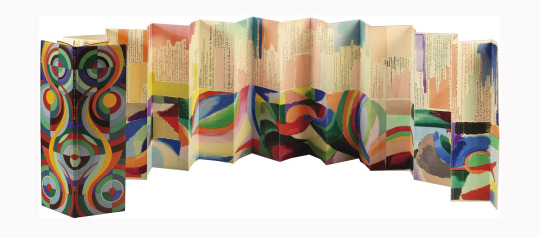
What an exciting project I have been involved in through my most recent bookbinding commission: the recreation of La Prose du Transsbérien et de la Petite Jehanne de France - the remarkable book by poet Blaise Cendrars and artist Sonia Delaunay. Sonia and Blaise first met in January of 1913 and formed an instant friendship, producing this book by letterpress and pochoir in 1913. The original book was a landmark achievement for its time and remains vibrant and modern today.
The recreation project was conceived by Kitty Maryatt, the proprietor of Two Hands Press in Playa Vista, California since 1974. In 2017 she decided to publish the recreation with the help of underwriters. Kitty has created a blog of her own documenting her journey through the process of recreating 150 editions as closely as possible to the original book by using letterpress and pochoir. Her blog is totally fascinating can be found here. It is thanks to this blog, plus some additional information that was printed to be housed with the completed book, that I am able to pass on so much information about this latest binding of mine.
The image above shows the binding made by Paul Bonet between 1963-64, sold by Christie’s in Paris on April 29, 2004 for 350,000 Euros. Sonia and Blaise had planned on making 150 copies however this was not completed.
“Was the primary reason for the incomplete edition the excessive length of time it might take to complete the pochoir process, assuming that the pochoir was the final procedure before binding? Did World War I intervene? Were there exhibits of the book, any reviews, any publicity at all? Were the sales disappointing? Did they run out of money?”
The actual number remains unknown, 74 have been identified but the list of these has never been published.
“The edition numbering system Blaise Cendrars used is somewhat random, indicating that the edition numbers were not written on the copies when they were first made. For example, there are two copies numbered 47, two numbered 111, and two numbered 139. Many copies do not have an edition number. There is a copy numbered 1 and one numbered 150.”
The La Prose of 1913 was printed on three materials: vellum, Japon and simile Japon, they stuck to the typical formula of publishing a deluxe edition and regular edition. Japon in one of many Japanese papers sold by the Japan Paper Company; simili Japon is made with Western fibres, also sold by the Japan Paper Company. The Paul Bonet binding is one of the vellum editions.
The below image shows Kitty’s recreation (right) alongside an original copy at The Getty Research Institute, Los Angeles, CA (left). This is #124, glued and folded into 21 panels, inscribed to Archipenko, the vellum cover is not attached.
“The book itself is captivating with its colorful and painterly pochoir (French-style stencil), so unlike stenciled copies of artwork at the time. The colors seep from the painted side into the poem on the other side.”
Kitty wanted to recreate the pochoir methods as closely as possible to the original using pommes (short, wide brushes) and metal stencil plates. Pochoir is a refined stencil-based technique employed to create prints or to add colour to pre-existing prints. It was most popular from the late 19th century through the 1930's with its center of activity in Paris. Numerous stencils were designed as a means of reproducing an image. (Photo courtesy of Kitty Maryatt)
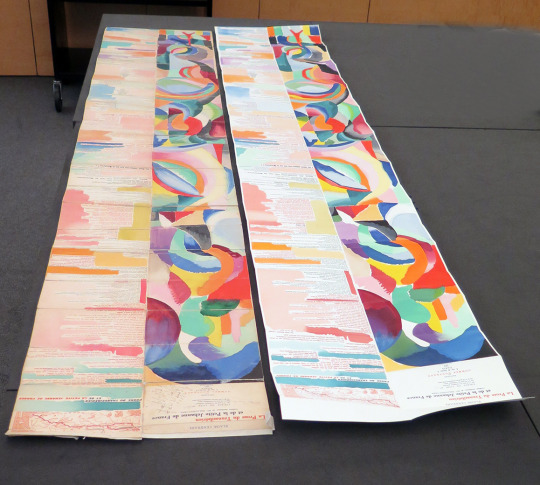
My copy was one of two that Neale Albert (New York) had underwritten and commissioned. When I received my copy of the sheets in the post (#58 0f 150) they came with three different instruction sheets of how the pages could be folded - it was rather daunting!
The long vertical format of the book was an unprecedented choice for a book of the period:
“The Trans-Siberian Railroad was begun in 1890 when Blaise Cendrars was only three years old, but it was highlighted at the 1900 Exposition Universelle in Paris that he attended with his family. The entire series of railroad lines weren't actually completed until three years after La Prose du Transsbérien was published. In the book, Blaise included a map of the journey from Moscow to Vlasivostok, which gives us a clue as to the distinctive folding scheme of the book. I've found tourist maps of Paris for the period similarly folded, in half first, and then in accordion – folded flat and glued to the cover. In the case of La Prose, as you open the book, you can't actually see anything in the book, neither the text nor the imagery, until the book is completely unfolded.”
It was up to me to choose which format I wished to use having been instructed that there was no set way of binding the book, so total creative freedom! Along with the written instructions, Kitty also sent all binders images of the folding and gluing process - crucial information to have before proceeding. There were three ways of folding the concertina, either like the original (left hand format), long and thin like the Paul Bonet binding (middle format) or double width (right hand format). (Photo courtesy of Kitty Maryatt)
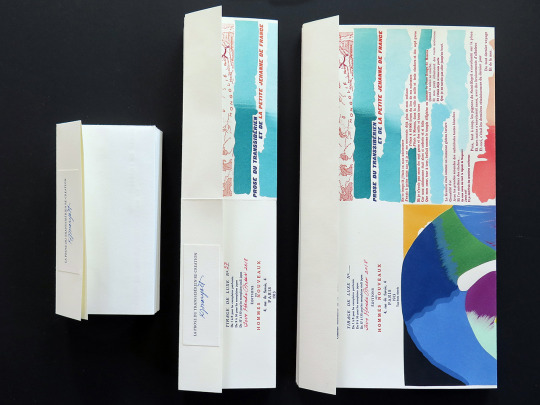
The 1913 edition book covers were painted in oils by Sonia Delaunay, some covers had a snap, which made the book resemble a purse. Kitty’s version of La Prose is bound with vellum covers however she used acrylic paint to decorate the cover as she found that the oils yellowed the vellum. The book is housed in an acrylic slipcase and is pictured below. (Photo courtesy of Kitty Maryatt)

So, the time had come to trim and stick all of my sheets together!
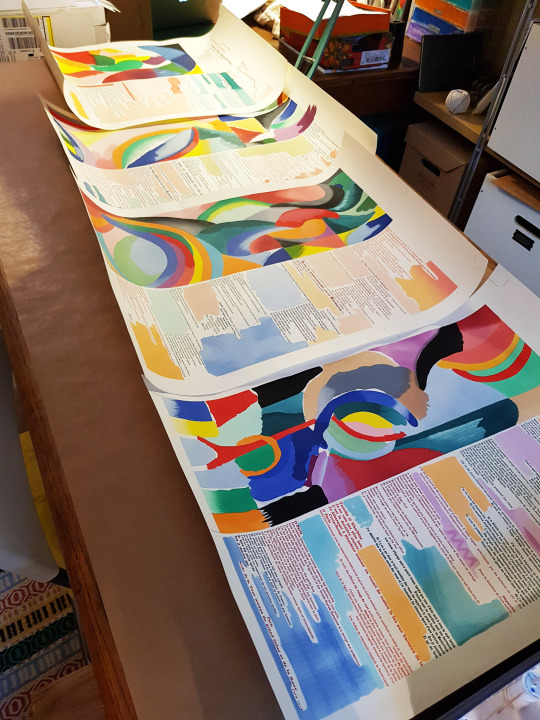
The first step was to cut all four pages to size. I am used to working in cm, I have almost never used inches, so the fact that all of the instructions were in imperial took extra brain power - I never even glance at the other side of the ruler!
The first step was to measure 7 1/18 inches from the centre fold mark at the top and bottom and to cut off one vertical side.
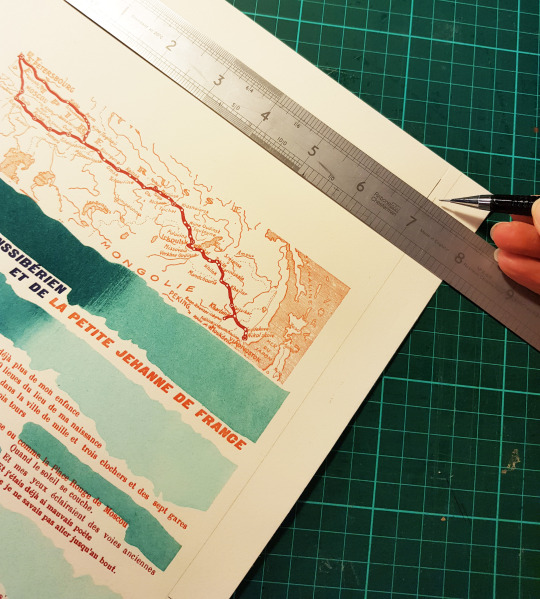
The next was to cut off the other vertical side so that the width of the page was 14 1/14 inches and the two sides were parallel.
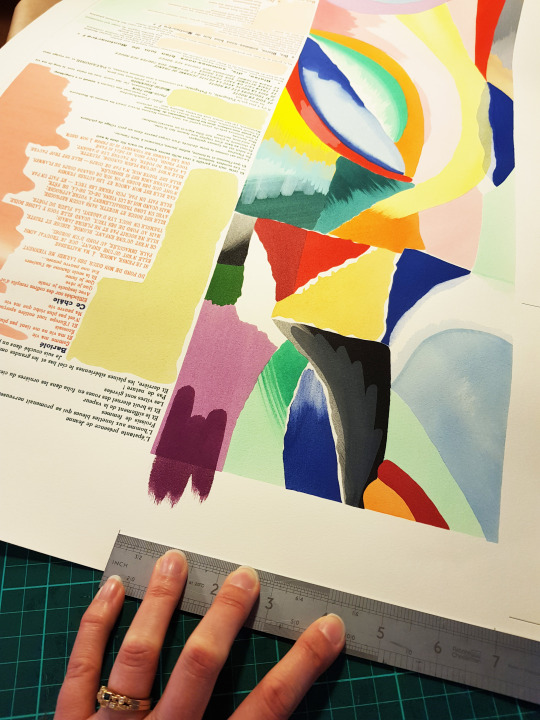
Next I had to cut off one inch at the top of page one, and to trim the top of pages 2 to 4 at the printed mark on the right side just above the first line of type. The bottoms of each page then had to be cut to meet the following lengths: Page 1 - 21.75 inches, Page 2 - 20.25 inches, Page 3 - 19.875 inches and Page 4 - 19.5 inches.
I was then able to proceed with gluing all four sheets together. I soon found I didn’t have a long enough table to work on but managed to get around that by moving two next to each other! The cut edges of the sheet were not thinned or pared in any way, they were stuck together at full thickness (the same as with the original binding).
Pages one and two were lined up along their edges, overlapping by 3/4 inch. Each page was glued to about 1/2 inch in, so that when overlapped all of the paper overlap was covered in glue. The reverse of the upper page was glued, then the front of the lower page before being combined.
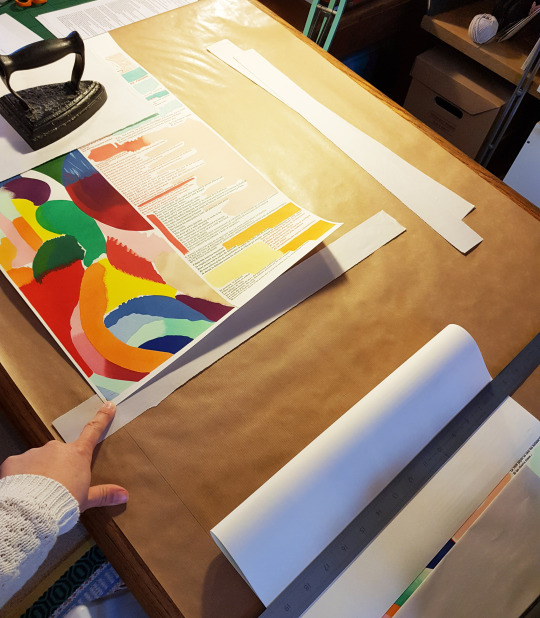
A weight was applied to the glued joint afterwards and I waited for it to dry before moving on to gluing the next joints. The instructions stated:
“Note that the images don’t line up completely at the joints. I copied the original exactly. Why did they do that? It’s odd from our perspective. The outside lines should line up pretty well if you cut to size carefully.”
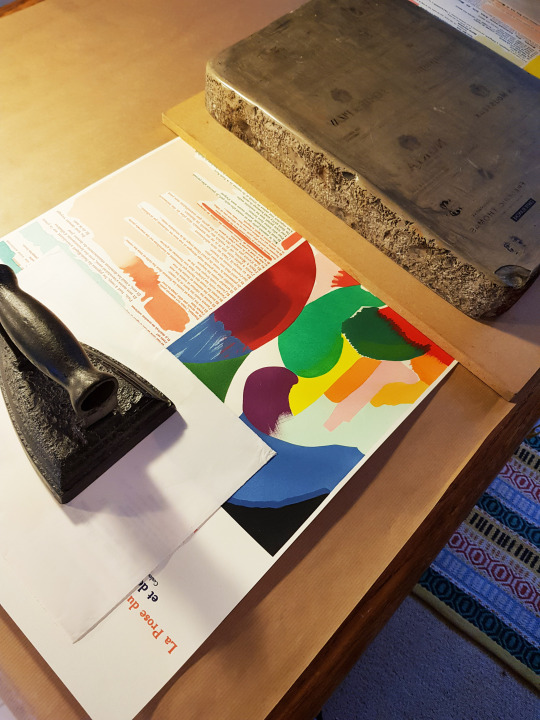
Once all four sheets were glued together is was time to start folding. Her the instructions did actually switch to being in centimetres!
“Folding: I use a jig of board cut to 197mm. I place the board on to the paper at the bottom edge, blank side up, place the ruler next to the left side of the board, remove the board, and score the paper 197mm from the bottom edge, and fold up. The next fold is 197mm from the first fold, I score on the blank side and reverse the fold (or you can flip the book if you wish). Continue until you get to the top, where you will have a tab left for attaching to your binding, if you wish.”
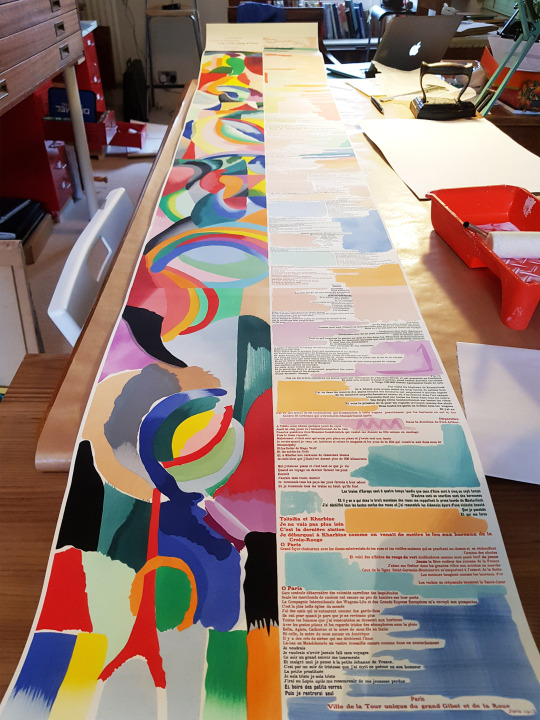
These folding instructions left me with a text block to the largest format possible. I deliberated for a long while whether to keep it at this size, but in the end took the plunge and did an additional fold in each section to give me a text block that was half the width, so the same format as that of the Paul Bonet binding.
Once I had the text block size it was time to start designing the cover. I knew that I wanted to use embroidery, as I always do, so set about making sure I had threads to match all of the wonderful pochoir colours.
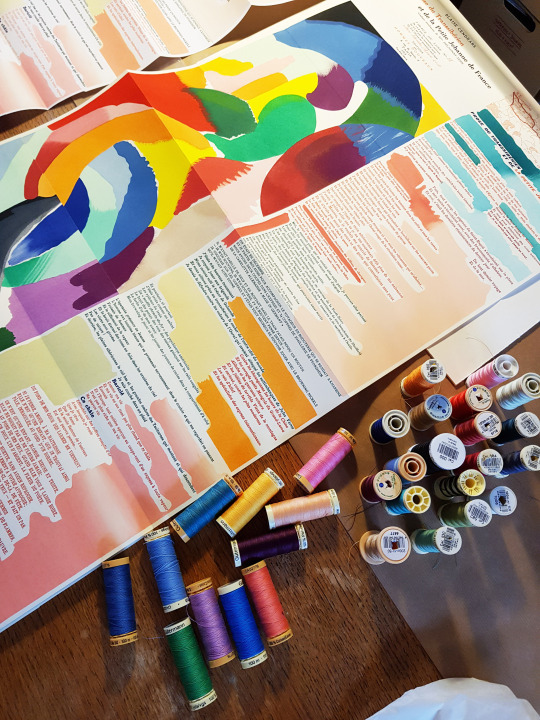
I decided to do some research into Blaise Cendrars. Blaise Cendrars was the pen-name for Fréderic Louis Sauser - a play on Braise (ember) and Cendres (ash). He was a Swiss-born novelist and poet who became a naturalised French citizen in 1916. He was a writer of considerable influence in the European modernist movement.
His writing career was interrupted by World War I, he was sent to the front line in the Somme from mid-December 1914 until February 1915. It was during the attacks in Champagne in September 1915 that Cendrars lost his right arm and was discharged from the army.
As he was right-handed, he had to learn how to write with his left hand following the war. I decided to try and find handwriting examples of his from before and after he lost his right arm which was possible online. It would have been wishful thinking to find a handwritten transcript of La Prose, however I did find some good examples of both his left and right handwriting on other documents.
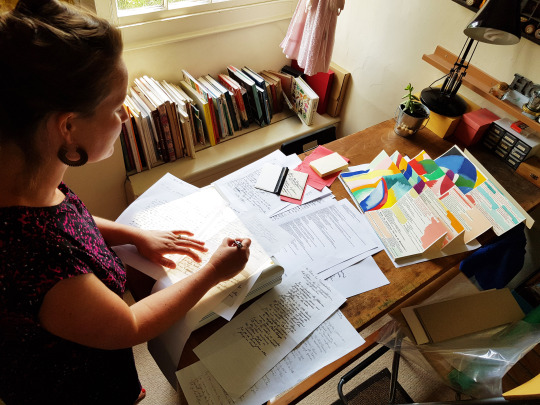
What I decided to do was to transcribe parts of the poem in each of these handwriting styles to use on the front and back of the book. I used a typed print out of the poem to refer to and found example of whole words (if possible), or individual letters, from the documents I had found, and pieced these together to try and reflect the writing style of before and after the loss of his arm - the left hand writing was more haphazard and scribbly-looking. What I couldn’t work out at first though was which should go on which cover!
I put the question to some family and friends and got some great feedback. What I hadn’t thought about before was that if I did the “before” handwriting on the front and the “after” handwriting on the back, when the book was opened up or laid flat I would have the writing on the sides which naturally correspond to the hands which were used - the decision was made.

So the “after” left handwriting became the design for the back board, and I took wording from the beginning of the poem.
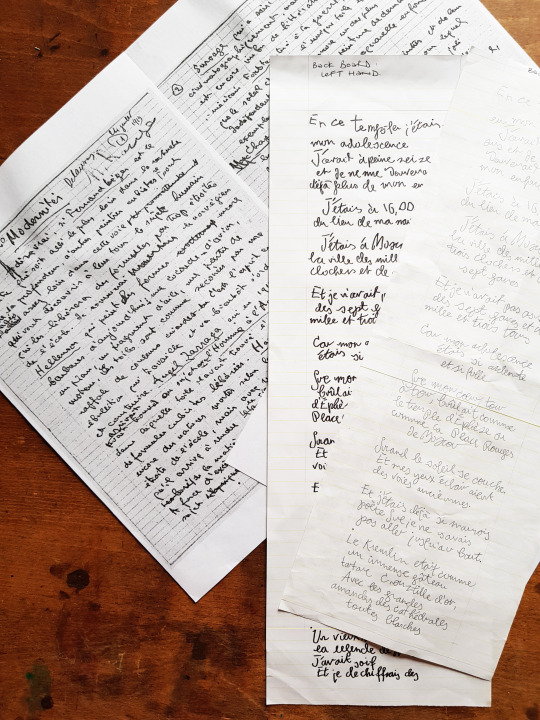
And the “before” right handwriting became the design for the back board, and I took wording from towards the end of the poem.
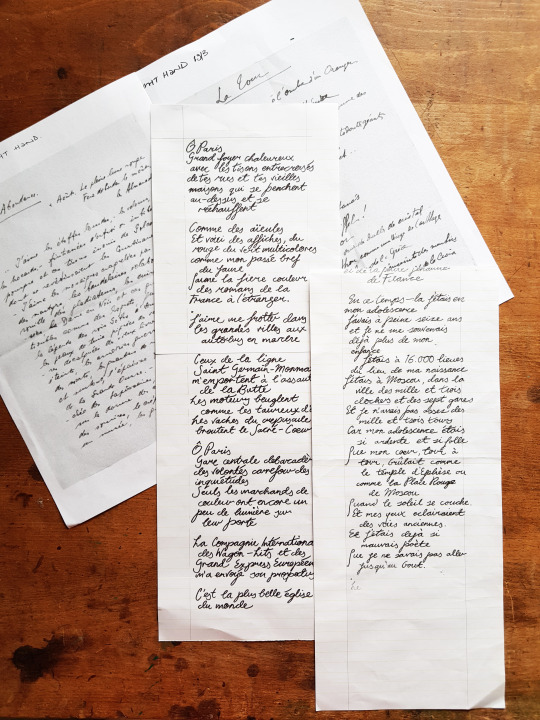
It took a few attempts to get it to the right width for the boards, and to get enough words on so that the front and back covers started and ended at the same heights. For each of the covers I photocopied the writing onto tracing paper templates so I had a master copy to work from.
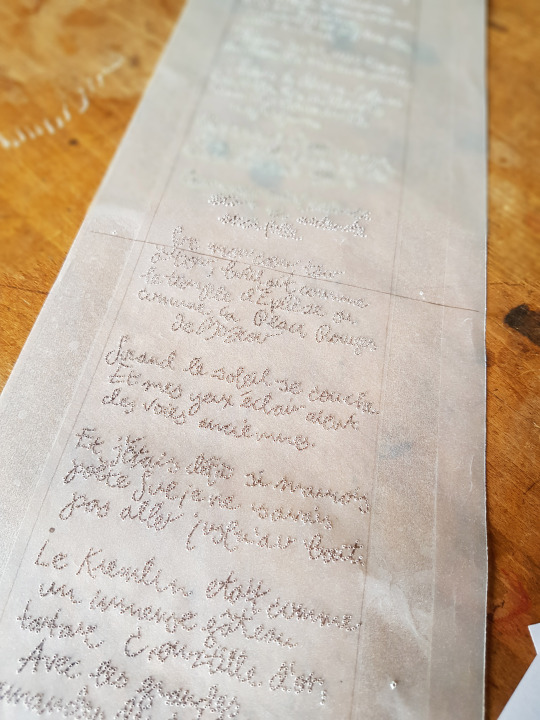
During the period of time I was working on this binding I made a trip to London to see the British Library’s exhibition entitled, Writing: Making Your Mark.
“Writing: Making Your Mark is a landmark British Library exhibition, which spans 5,000 years across the globe, exploring one of humankind’s greatest achievements – the act of writing. From carved stone inscriptions, medieval manuscripts and early printed works to beautiful calligraphy, iconic fonts and emojis, Writing: Making Your Mark (26 April – 27 August 2019) will deconstruct the act of writing and consider its future in the digital age.”

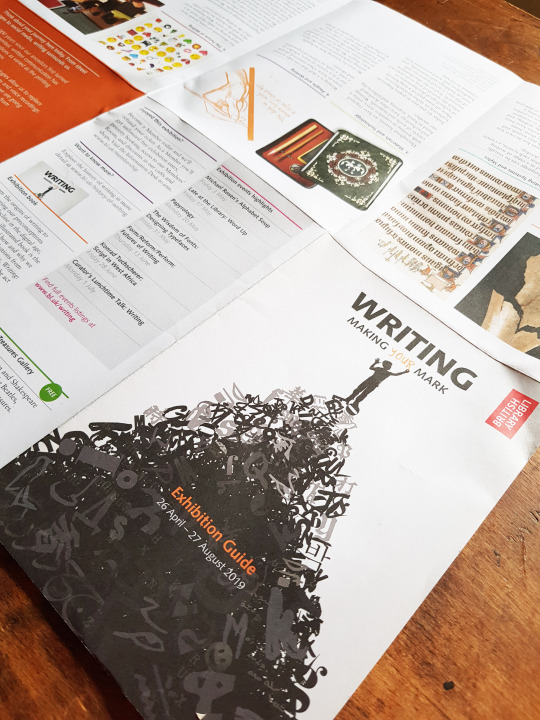
What a timely exhibition to be on whilst I was making my own mark with the handwriting of Blaise Cendrars.
“People first created writing 5000 years ago, its invention revolutionised society. Writing began in a number of locations around the world, at different times and for different reasons. People developed it to communicate across time and space, carrying it with them as they traded, migrated and conquered.”
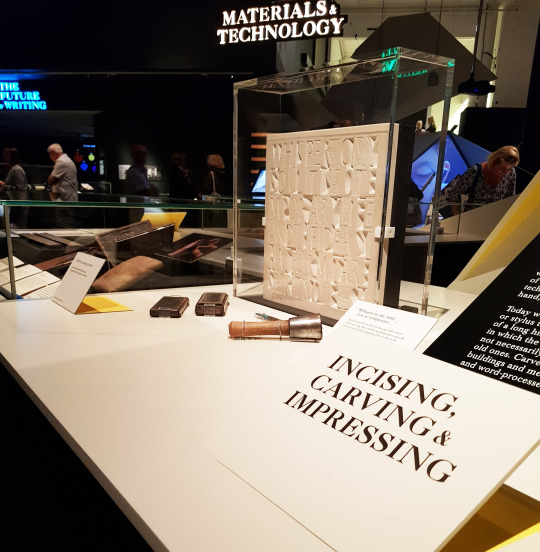
It is amazing to think that writing and technology have often developed hand in hand. What began as inscribed patterns on bones thousands of years ago has somehow led to me sitting at my computer typing away at this blog on a keyboard. I hope I have done Blaise Cendrar’s two versions of handwriting justice in my binding!
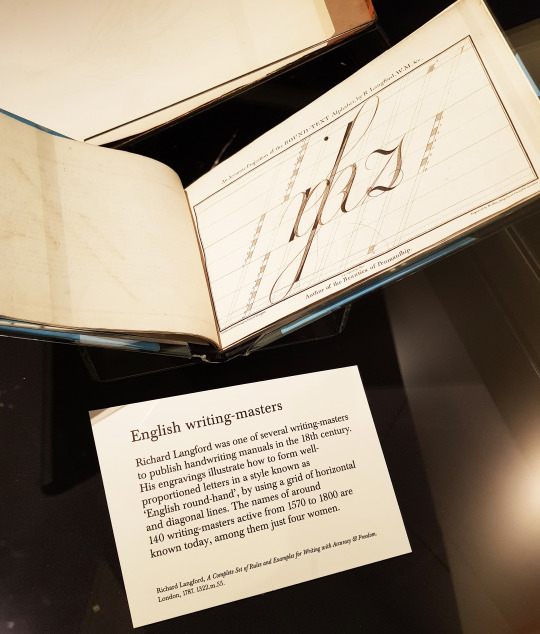
In August 2015 Kitty identified thirty-eight distinct typefaces used in La Prose.
“Blaise Cendrars printed La Prose at Imprimerie Crété in Corbeil, France because he was already in the process of printing his second book, Séquences, at Crété in early 1913. The poem is four hundred and forty-five lines long. In a brilliant and groundbreaking master stroke, Blaise decided to select dozens of typefaces for the poem.”
She was convinced that Blaise did not walk along the hundreds of type cabinets at Crété impulsively selecting type: Crété certainly would have had an in-house type catalogue to view the available typefaces.
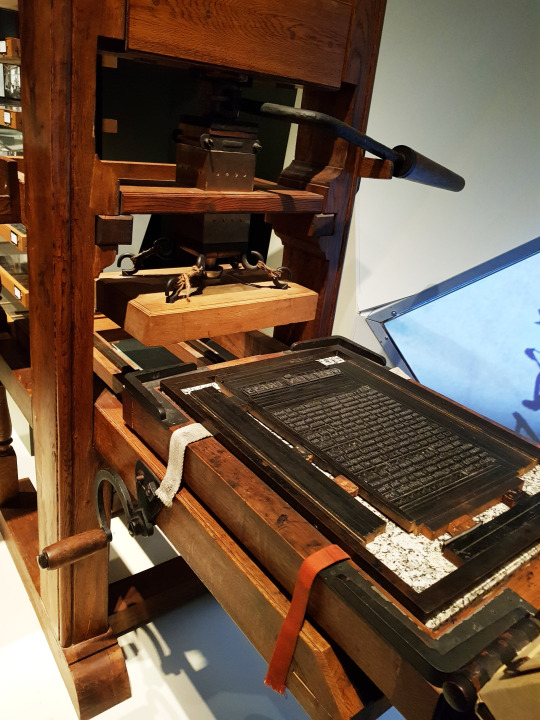
The next blog post will go through the choices I made when it came to binding such a book, “La Prose Part Two: Structure”.
#la prose#la prose du transsibérien#sonia delaunay#blaise cendrars#kitty maryatt#british library#writing#making your mark exhibition#bookbinding#bookbinding commission#reliure#reliure d'art#livre d'art#pochoir#stencilling#typesetting#handwriting#left handed#right handed#two hands press#hannah brown#hannah brown bookbinder#shepton mallet#bowlish#embroidered binding#vellum binding
8 notes
·
View notes
Text
12/31/19
Looking back to 2019
January & February
It is filled with adventure and thrill because I explored different places without asking my parents' consent tho. I went to ek and moa with my college friends.
March
I also explored some parts of manila and also enrolled to my review classes for boards.
April - September
I still have classes that time. May was our retreat and it was held in baguio but we didn't have enough free time to explore the city during our last day. Also in this phase, so many what ifs are disturbing my inner peace. Those nights wherein I cried my heart out thinking that what if I will not graduate from 5th year and after that I don't know what my next step will be. Those nights full of regrets that I should have given all my best in studying so that I have not failed my accrev. It also made me think if I really wanted to continue this journey, to become a cpa. I was also exhausted emotionally, physically and mentally that I just gone with the flow. I felt like I lost the fire inside me to continue. After some time, I regained the fire, I was motivated and inspired to fight again. I studied my heart out to pass the exam given as our "second chance".
I was feeling positive to study for the review season which also started this May. Tbh the first part of my review season, I was a lil bit excited because I can feel how to be independent because I was all alone in my dorm, my dorm mates were going home every weekends. I felt like I was in a kdrama and it was fun because I don't have to deal with other people but as weeks passed by, I felt so lonely. I felt the exhaustion of travelling back and forth to the province and such. I felt tired and lazy to study. Tbh I was demotivated to study, I lacked the work and just depended on prayer alone. At first, my thinking was that, I'll pass the boards no matter what, but as the day of the cpale went closer, the doubt was slowly getting bigger.
I also happened to attend my first fangirling event for this year which is Dylan Wang's fm brought by Bench. It was really so fun and I felt that I am alive! I think I was born to be a fangirl lol.
Dorm moments and bonding with dorm mates, those things made our bonds stronger with some of my college friends. Being with them to that phase in my life, really is a big part. Those adulting chika, walwal and foodtrip -- simple things that I really cherish.
October
CPALE season, that 2 weeks was like a torture, including the waiting for the results. I kept thinking positive and claiming that I'll passed but every end of the day, I saw myself going to St. Jude and crying. My heart was so heavy. I kept praying and surrending everything to Him. Crying out to Him, I felt like the heavy burden in my heart was lifted. While waiting for the results, I claimed and at the same time thought that I did not passed but the thinking that I failed weighing the most. Those relatives asking me about the results made me teary eyes every time.
Results day, if I remembered it right I was anxious all day. The results were out at night, every notifications I got from PRC in twitter made my heart skipped a beat. When the time had come I was really nervous, i searched first for all my friend's name but only some of them made it. Then I searched for my name and found none. I didn't cry maybe because I cried everything whenever I went to St. Jude every after the exam day. I felt bad but seeing that almost of my college friends were in the same boat as mine, I felt comforted. Sorry, I know I'm mean. I also told my parents about it that night because I don't want to prolonged the disappointment the next day. Thinking that tomorrow will be another day; new hope for things to be better. Some of my friends were sending comforting messages and that made me teary eyes for a bit but after that I felt numb. I don't know what to do with my life. I felt lost. I felt empty. I think I also got to "tampo" with Daddy G because I knew I never failed to pray to Him every day, it was only later that I finally accepted that maybe it was really my fault. I was so lazy and demotivated. I only relied to prayers and not doing my part. I'm so sorry Daddy G 😭.
End part of October, I felt alive. I attended a fan meet. I happened to see Cha Eun Woo and became an Aroha. I think being a fangirl is really my calling lol.
November & December
November 1st and it is our fam's tradition to go to cemetery to visit our deceased loved ones. I didn't go there because my relatives from Manila were there and I thought I was not ready to face them.
I attended IU's con named Love, Poem. Hearing IU's singing live is just my goal but when I left the premises of Araneta, I became a certified Ma-aena. That 4 hours concert is really a daebak! ✨
I went to Elyu this December and I think it made me breathe for some time. I was a bit exhausted. I felt like I was being left behind because wearing bikini is not my cup of tea. I lacked confidence of my body.
These two months is filled disappointments, pressure, self pity, self doubts and so much more. I felt like I was a total failure. I envied those batchmates who are already hired and working as a corporate slave. I attended some interviews but unfortunately I was not hired. I was also judged by some of my relatives saying that maybe I was too picky for my first job. Yes, I declined a job offer because the salary is below the minimum and it does not offer to help me grow as a professional. I do believe that I can have more and I can do more that's why. It also made me think those what if I didn't pursue this course instead I took engineering, which I really wanted; maybe I am now an engineer. I felt lost after that boards season.
2019 is really a year of lessons, experiences and survival. It is just a 365 days but it gave plot twists which gave a mark in my being. It reminded me that I am living and living doesn't only mean that you are always at a top; living also means that you can be at the bottom. I am grateful for all the people who never left my side, who gave their never-ending support and love, who believes in me and who keeps me sane. Surviving this 2019 through He's help is already a gift.
Thank you Daddy G for guiding me throughout this year's journey despite those times that I almost turned my back to You. I'm deeply sorry if it took some time for me to realize that You just answered my prayers with "not yet" and not a stern "no". I am now trusting Your own timing. 💙
1 note
·
View note
Text
One hundred years ago today, Wilfred Owen, a Lieutenant in the 2nd Manchesters – and an as-yet unknown poet – fell to German guns in the crossing of the Sambre-Oise Canal in the Second Battle of the Sambre. Here’s a brief account of the final three years of his life, in which he joined the army, suffered wounds and shell shock, found his poetic voice in a hospital, and then perished almost exactly a week before the Armistice took hold and the guns went silent. The story will be told primarily in Owen’s own words, taken from his poems and Collected Letters (Oxford University Press, 1967), and illustrated with stereoviews depicting some of the places and situations that he discusses. The letters will be compressed for brevity’s sake, an as ever, an anaglyph gallery will be positioned at bottom.

Troops marching through Oise, near the canal where Owen died. Courtesy of the Boyd/Jordan Collection.
Joining Up
Having always been a sensitive and scholarly boy, with a literary mind – by age 10, he wanted to be a poet, and was enamored of the Romantics, particularly Keats – Wilfred Owen was an unlikely candidate for a military life. Indeed, at the outbreak of the war, Owen was living in France, working as a tutor, and immersing himself in the culture of the land – and he was in no rush to join up. He planned a trip to Havre, which was cancelled suddenly as passage was denied. When it became apparent that his options were narrowing, he wrote to his mother (henceforth Susan or SO):
Friday – I kept back these extraordinary announcements under a presentiment that my Voyage would not come off—and, indeed, at six o’clock this evening I learnt that it can’t be done. Principal reason stated—my English Nationality. The Voyage to Havre might be managed but not a Return. But, a fortnight next Saturday, I shall most undoubtedly be able to sail to Havre, & perhaps cross to Newhaven, free of charge, for I shall be returning to join the Army… –Addendum to letter to SO, postmarked Bordeaux, originally dated Wednesday 18 August 1915
It would be another two months before he officially joined up:
In the middle of this letter I was called to lunch; and then went to ‘swear in’. This time it is done: I am the British Army! Three of us had to read the Oath together; the others were horribly nervous! and read the wrong Paragraph until the Captain stopped them! ‘Kiss the Book!’ says Captain. One gives it a tender little kiss; the other a loud smacking one! … After that we had to be inoculated for Typhoid. And that is why I am in bed since four o’clock! The delightfully kind, confidence-inspiring doctor gave us full instructions. There were scores of Tommies taking the ordeal before me, and believe me some were as nervous as only fine, healthy animals can be before doctors. One fainted before his turn came, merely as a result of the Doctor’s description of possible symptoms! … We have sick leave until Monday morning. The hours are 9:30 to 4! Jolly reasonable! … The Poetry Bookshop is about 7 mins. walk! There is a Reading this very night! – Letter to SO, postmarked Les Lilas, 54 Tavistock Square, W. C., dated 21 October 1915
Clearly, Owen is still a bit naive as to what he’s signed up for – living in a French boarding house on the square in which Dickens resided whilst writing Bleak House, among other works, and amusing himself with evening poetry readings. Soon, however, he would be shipped off to training campt, and his attitude would change:
I was put on Guard Duty from 9 a.m. yesterday to 9 a.m. today. Miserable time: not allowed to take off packs or boots during 24 hrs. I was Sentry from 11 to 1 and 5 to 7 etc. a. and p.m. I was with fellows that I don’t like—chumps all of them. We got enough to eat; and I made toast on my Bayonet. There was not much Challenging to do. I am one of the orderlies again tomorrow. Now that the novelty is wearing off, this Camping is beginning to get troublesome. I had a card from Stanley Webb today. I am not off this weke end. How is everybody? You W.E.O. – Letter to SO, postmarked “From Cadet W.E.S. Owen, 4756/Hut 6a, Artists’ Reg’t C. Coy./Hare Hall Camp Romford Essex”, dated 28 November 1915.

Very likely a French version of the “chumps” that Owen so despised throughout his early months in the army. As he abhorred course language, excessive alcohol use, and so on, he found few peers early on in his time in the Army, as noted time and time again in his letters. Courtesy of the Boyd/Jordan Collection.
Owen would be training in various capacities – almost always seemingly annoying to him – until he was finally commissioned into the Manchester Regiment in June 1916. But after being denied a position in the Flying Corps, it was more training, as the 5th Manchesters were currently a reserve unit. Owen became an expert marksman, impressing his superiors, and on the 29th of December, he boarded a train to a shipyard – it appeared he was going abroad. In fact, he was to travel to France on New Year’s Day, 1917 – to join the 2nd Manchesters at the front.
The Somme
From arrival in France, it took three days to arrive at Owen’s first destination, the journey wasn’t pleasant, and the other soldiers were even more “chump-like” than his fellow cadets in Britain:
My own dear Mother, I have joined the Regiment, who are just at the end of six weeks’ rest. I will not describe the awful vicissitudes of the journey here … Since I set foot on the Calais quays I have not had dry feet … After those two days, we were let down, gently, into the real thing, Mud. It has penetrated now into that Sanctuary my sleeping bag, and that holy of holies my pyjamas. For I sleep on a stone floor and the servant squashed mud on all my belongings; I suppose by way of baptism. We are 3 officers in this ‘Room’, the rest of the house is occupied by servants and the band; the roughest set of knaves I have ever been herded with. Even now their vile language is shaking the flimsy door between the rooms. –Letter to SO, 4 January 1917. From this point, Owen may only note that he is sending his letters from the 2nd Manchester, so as not to divulge locations in the event of intercepted mail.
It wasn’t long before the young officer was thrown into the action, as the Battle of the Somme was already well underway – the German retreat to the Hindenburg Line was not far off – and Owen found himself in the abandoned village of Bertrancourt:
My own dear Mother, I have just received your long-looked-for letter. It seems wrong that even your dear handwriting should come into such a Gehenna as this. There is a terrific Strafe on. Our artillery are doing a 48 hours bombardment … When we arrived at this deserted Village last night, there had been no billets prepared for the Battalion … for my part I … discovered a fine little hut, with a chair in it! A four-legged chair! The Roof is waterproof, and there is a Stove. There is only one slight disadvantage: there is a Howitzer just 70 or 80 yards away, firing over the top every minute or so. – Letter to SO, 9 January 1917.
The Somme was often like that – every time one side advanced, it would take advantage of whatever features it had captured, down to abandoned huts, destroyed farmhouses, and so on.
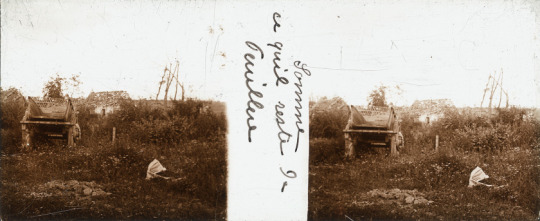
A farm at the Somme, rather more devastated than the one Owen stayed at on 9th January. From my collection.
A week later, Owen would finally be truly battle-tested, capturing his first dugout:
I am sorry you have had about 5 days letterless … I can see no reason for deceiving you about these last 4 days. I have suffered seventh hell. I have not been at the front. I have been in front of it … I held an advanced post, that is, a ‘dug-out’ in the middle of No Man’s Land … we had a march of 3 miles over shelled road then nearly 3 along a flooded trench. After that we came to where the trenches had been blown flat out and had to go over the top. It was of course dark, too dark, and the ground was not mud, not sloppy mud, but an octopus of sucking clay, 3, 4, and 5 feet deep, relieved only by craters full of water. Men have been known to drown in them. Many stuck in the mud & only got on by leaving their waders, equipment, and in some cases their clothes … High explosives were dropping all around out, and machine guns spluttered every few minutes … we reached the dug-out, and relieved the wretches therein. –Letter to SO, 16 January 1917.
And a few days later, had his first experience with something that would be one of the focal points of his most well-known poem, Dulce et Decorum Est:
I went on ahead to scout—foolishly alone—and when, half a mile away from the party, got overtaken by
G A S
It was only tear-gas from a shell, and I got safely back (to the party) in my helmet, with nothing more than a severe fright! And a few tears, some natural, some unnatural … They want to call No Man’s Land ‘England’ because we keep supremacy there. It is like the eternal place of gnashing teeth ; the Slough of Despond could be contained in one of its crater-holes; the fires of Sodom and Gomorrah could not light a candle to it—to find the way to Babylon the Fallen … It is pock-marked like a body of foulest disease and its odour is the breath of cancer … No Man’s Land under snow is like the face of the moon chaotic, crater-ridden, uninhabitable, awful, the abode of madness … To call it ‘England’! I would as soon call my House (!) Krupp Villa, or my child Chlorina-Phosgena. – Letter to SO, 19 January 1917.
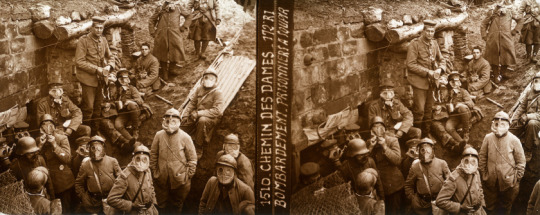
Soldiers in a trench prepared for a gas attack, as Owen would come to be – imagery such as this pops up in many of his poems, most notably in “Dulce et Decorum Est”. Gas warfare was an everyday hazard during the Great War. Courtesy of the Boyd/Jordan Collection.
Besides the intermittent bombardments, Howitzer fire, and gas attacks, life on the front was quite mundane – even officers such as Owen were expected to help dig and reinforce the trenches, a chore he found terribly boring – and complained about to his mother with almost as much frequency as his constant requests for socks, cigarettes, chocolates, and volumes of poetry. It is fairly safe to say that this last item probably stood out among officers at the Somme front at that time. In any case, Owen hated digging trenches.
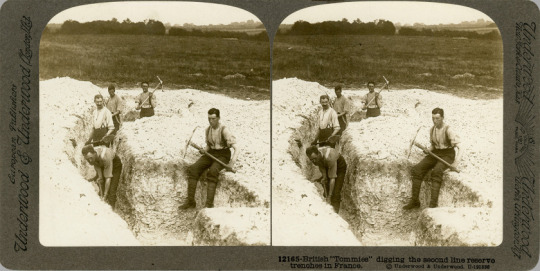
British soldiers digging second-line trenches, hence their relaxed poses. Owen was on the front line. From my collection.
Then, on March 14th, the monotony was broken, as it were, by a fall. In a letter which does not survive, but which was quoted by Edmund Blunden whilst writing his memoirs, Owen wrote from Le Quesnoy-en-Santerre:
Last night I was going round through pitch darkness to see a man in a dangerous state of exhaustion. I fell into a kind of well, only about 15 ft., bur I caught the back of my head on the way down. The doctors (not in consultation!) say I have a slight concussion. Of course I have a vile headache, but I don’t feel at all fuddled.
But the next his mother heard from him, the situation had changed:
My dearest Mother, I am in a hospital bed, (for the first time in life.) After falling into that hole (which I believe was a shell-hole in a floor, laying open a deep cellar) I felt nothing more than a headache, for 3 days; and I went up to the front in the usual way—or nearly the usual way, for I felt to weak to wrestle with the mud, and sneaked along the top, snapping my fingers at a clumsy sniper. When I got back I developed a high fever, vomited strenuously, and long, and was seized with muscular pains. The night before last I was sent to a shanty a bit further back, & yesterday motored on to this Field Hospital, called Casualty Clearing Station 13. It is nowhere in particular that I know, but I may be evacuatd to Amiens, if my case lasts long enough. – Letter to SO, 18 March 1917.

A field hospital in France, much like the one Owen mentions in the above letter, photographed by A. O. Fasser, an American surgeon who came over to give aid during the Great War. Courtesy of the Boyd/Jordan Collection,
During the stay of a couple of weeks in Amiens, Owen became increasingly bored, as reflected in his musings about the terrible people in the hospital, a sudden desire to become a pig farmer (!), sketches of bungalows he could imagine himself living in, and so forth, that he would constantly send off to his mother, brothers, sisters – really, anybody whose address he had committed to memory. Around this time, he was having conflicting thoughts – he was beginning to adapt to life at the front, while meanwhile, he was imagining himself in easier roles, such as a hospital assistant:
The man in the next bed told me this. We have two cases, pilot & observer, who are terribly smashed. They will both recover, but the pilot has both arms broken, abdominal injuries, both eyes contused, nose cut, teeth knocked in, and skull fractured. It makes me ashamed to be here. But I help to look after him at night. The sister has a wonderful way with him. I like her very much. Constitutionally I am better able to do Service in a hospital than in the trenches. But I suppose we all think that. -Letter to SO, 30 March 1917.
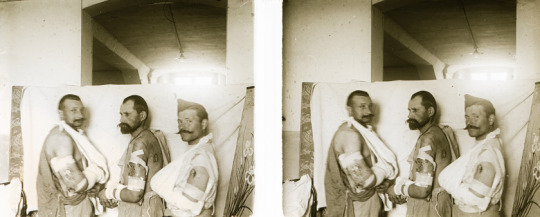
Another of A. O. Fasser’s photographs, of three injured soldiers recovering in a field hospital. Owen clearly felt both inadequate (in not having sustained as serious an injury as most of the dozen or so men in that hospital at the time), but also superior to the wounded men – in that he did not feel that they were worth conversing with. His attitudes would soon change. Courtesy of the Boyd/Jordan Collection.
In direct contradiction to the sentiment from the 30th March letter, however, his following letter is very telling as to his evolving (or, perhaps, devolving) mental state:
Dearest Mother, Know that I have cut my forefinger with a tin of Lobster, and that is why I write shaky. I have just been 4 days caravanning from the CCS, & have just found our H.Q. Journeying over the new ground has been most frightfully interesting. The Batt. has just done something great which will find its way to the Communiqué. I am going up to join them in an hour’s time. They have lost one officer & many are wounded, Haydon among them. I shall no doubt be in time for the Counter Attack. I have bought an automatic pistol in town (from which I sent a P.P.C.) By the time you read this we’ll be out of the line again. … Tonight will be over . . . . My long rest has shaken my nerve. But after all I hate old age, and there is only one way to avoid it! – Letter to SO, 4 April 1917.
When Owen returned to the front, with a shaky hand and admittedly shaky nerves, he arrived to find his commanding officer dead, many of the men badly wounded, and morale terribly low. His orders were to find out the position and strength of the enemy near the trench he was defending – and that meant giving away his position. After casually alerting the enemy of the Manchesters’ presence in the trench, two heavy machine guns bore down on the area. Owen now knew that he was facing a tougher enemy, with little recourse – so he and his men held on, as low as possible, for four days and nights, until it was safe to retreat. In the midst of this, the man standing next to him took a bullet through the bicep – and Owen wrote home with a detached tone that he was envious of the man.
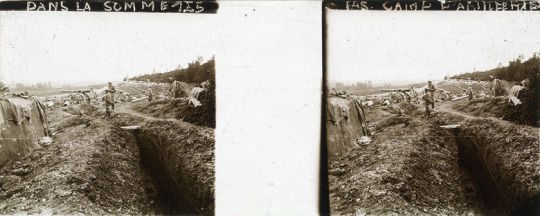
A typical trench at the Somme, presumably much like the one Wilfred Owen was defending in early April. From my collection.
On 9th April, Owen posted a half-completed letter to his brother Colin – whom he had previously written to his mother “would not last three weeks in this sector of Hades” – describing in impersonal, almost robotic detail the killing power of the Bosch machine gun. After this, no word reached any of Owen’s family members until the 25th, when the following letter – reproduced below in its entirety – was posted to Susan:
My own dearest Mother, Immediately after I sent my last letter, more than a fortnight ago, we were rushed up into the Line. Twice in one day we went over the top, gaining both our objectives. Our A Company led the Attack, and of course lost a certain number of men. I had some extraordinary escapes from shells & bullets. Fortunately there was no bayonet work, since the Hun ran before we got up to his trench. You will find mention of our fight in the Communiqué; the place happens to be the very village which Father named in his last letter! Never before has the Battalion encountered such intense shelling as rained on us as we advanced in the open. The Colonel sent round this message the next day: ‘I was filled with admiration at the conduct of the Battalion under such heavy shellfire . . . The leadership of officers was excellent, and the conduct of the men beyond praise.’ The reward we got for all this was to remain in the Line 12 days. For twelve days I did not wash my face, nor take off my boots, nor sleep a deep sleep. For twelve days we lay in holes, where at any moment a shell might put us out. I think the worst incident was one wet night when we lay up against a railway embankment. A big shell lit on the top of the bank, just 2 yards from my head. Before I awoke, I was blown in the air right away from the bank! I passed most of the following days in a railway Cutting, in a hole just big enough to lie in, and covered with corrugated iron. My brother officer of B Coy, 2/Lt Gaukroger lay opposite in a similar hole. But he was covered with earth, and no relief will ever relieve him, nor will his Rest will be a 9 days-Rest. I think that the terribly long time we stayed unrelieved was unavoidable; yet it makes us feel bitterly towards those in England who might relieve us, and will not.
We are now doing what is called a Rest, but we rise at 6.15 and work without break until about 10 p.m. for there is always a Pow-Wow for officers after dinner. And if I have not written yesterday, it is because I must have kept hundreds of letters Uncensored, and enquiries about Missing Men unanswered [remainder missing] – Letter to SO, 25 April 1917, from “A. Coy., My Cellar”
But Owen hadn’t told the whole story. During the barrage, over 30 men under Owen’s command had died. But that wasn’t the worst of it. The “Rest” Owen mentions above quickly turned into one of the most transformative experiences of his life – he was examined by a doctor before being returned to the front, but the doctor found explicit signs that he was suffering from what at the time was known as Neurasthenia, but was commonly referred to as shell shock. The reason would become clear in a later letter to his sister, again reflecting a detached tone:
You must not entertain the least concern about me because I am here. I certainly was shaky when I first arrived. But today Dr. Browne was hammering at my knees without any response whatever. (At first I used to execute the High Kick whenever he touched them) i.e. Reflex Actions quite normal. You know it was not the Bosche that worked me up, nor the explosives, but it was living so long by poor old Cock Robin (as we used to call 2/Lt. Gaukroger), who lay not only near by, but in various places around and about, if you understand. I hope you don’t! – Letter to Mary Owen, 10 May 1917.

Corpses of men killed by trench bombardment – but not in the sort of close quarters that Owen had shared with what remained of “Cock Robin”. Courtesy of the Boyd/Jordan Collection.
Wilfred Owen had lain in shock, for days, without food nor drink, amidst the fragmented corpse of his friend. This would be a shock to anybody. And while Owen was not quite the naive, sensitive lad who’d signed up with the Artists’ Rifles, he was not dulled enough to the horrors of war not to be shaken to his core by this experience. He shifted hospitals a couple of times, before finally arriving at Craiglockhart Hydropathic Hospital in Edinburgh.
Craiglockhart, Return to the Front, and Death
It was at Craiglockhart that Wilfred Owen came into his own as a poet. But first, there was some other business to attend. He continued to write letters rather constantly, which is why such a rich archive of his thoughts during this time period exists. He experimented with poetry, and sent drafts of many poems – most of which only exist as uncompleted fragments in a 1983 collection, “The complete poems and fragments” edited by John Stallworthy – to his family members and friends.
Notably, he was first published in Craiglockhart’s fortnightly literary magazine, The Hydra, which he also promptly took over editing on the advice of his doctor. He not only edited the journal, but anonymously wrote articles, editorials, and commentaries. Although during this period he occasionally yearned for the action of the front, he was content to delve into poetry, further exploring the poets of his youth, whilst biting into newer poets, such as Elizabeth Barrett Browning, of whose work he was immediately enamored. But it was the arrival of a notable “patient” at the hospital that really gave Owen the spark to create his greatest works.
In late July, Siegfried Sassoon arrived, already a published poet, and somewhat notoriously brave (there’s an oft-repeated tale that he once scared off 60 German soldiers by recklessly throwing grenades, singlehandedly capturing a machine gun nest – and then forgot about it entirely, pulling out a book of poems and reading at the nest, and confounding his superiors who didn’t know whether he was alive or dead). Sassoon was a bit of a sore spot for the British government at the moment; he’d published a statement that was read in front of the House of Commons condemning the war. Thus, he’d been placed in Craiglockhart to “recuperate” – in other words, to stay out of trouble. But in August, Owen and Sassoon would cross paths, and immediately take to one another:
At last I have an event worth a letter. I have beknown myself to Siegfried Sassoon. Went in to him last night (my second call). The first visit was one morning last week. The sun blazed into his room making his purple dressing suit of a brilliance—almost matching my sonnet! He is very tall and stately, with a fine firm chisel’d (how’s that?) head, ordinary short brown hair. The general expression of his face is one of boredom. Last night when I went in he was struggling to read a letter from Wells; whose handwriting is not only a slurred suggestion of works, but in a dim pink ink! Wells talks of coming up here to see him and his doctor; not about Sassoon’s state of health, but about God the Invisible King. … Next day – … So the last thing he said was ‘Sweat your guts out writing poetry!’ ‘Eh?’ says I. ‘Sweat your guts out, I say!’ He also warned me against early publishing: but recommended Martin Secker for a small volume of 10 or 20 poems. [Here Owen actually inquires about the addressee of his letter briefly, before returning to Sassoon.] Sassoon quite admires Thos. Hardy more than anybody living. I don’t think much of what I’ve read. Quite potatoey after the meaty Morals. You’ll have had enough of Sassoon, what? Just one more tit-bit. Wells said in his last letter: hope you will soon ‘devote yourself to the real business of your life, which is poetry only by the way.’ Poor Wells! We made some fancy guesses as to what he meant:—Tract-writing? stump-oratory? politics? what? Cheero! I’m well enough by day, and generally so by night. A better mode of life than this present I could not practically manage. – Letter to Leslie Gunston, 22 August, 1917.
Clearly, Owen was enamored with Sassoon from the get-go. Over the next couple of days, he wrote letters to Susan, to his father, Tom, to his sister Mary, and quite possibly to others raving of Sassoon’s virtues. The two became fast friends, albeit in a relationship marked by an imbalanced power dynamic – the younger Owen practically worshiped Sassoon, so much so that he’d write alternate drafts of some of his earliest (and one of his best known) war poems, and have Sassoon choose versions, wordings, even titles, as he did in the case of what was originally titled “Anthem to Dead Youth”, and then “Anthem for Dead Youth”, and finally the poem we all know today:
Anthem for Doomed Youth
What passing-bells for these who die as cattle? -Only the monstrous anger of the guns. Only the stuttering rifles’ rapid rattle Can patter out their hasty orisons. No mockeries now for them; no prayers nor bells; Nor any voice of mourning save the choirs, – The shrill, demented choirs of wailing shells; And bugles calling for them from sad shires.
What candles may be held to speed them all? Not in the hands of boys but in their eyes Shall shine the holy glimmers of goodbyes. The pallor of girls’ brows shall be their pall; Their flowers the tenderness of patient minds, And each slow dusk a drawing-down of blinds.
–Wilfred Owen, written at Craiglockhart in September-October 1917, with the assistance of Siegfried Sassoon
Sassoon would also introduce Owen to a great number of prominent figures in the literary circles of the era, including Robbie Ross and Robert Graves. It is through the latter that we most extensively know that Owen was homosexual (or, possibly, bisexual); although other sources confirmed it, Owen’s brother Harold posthumously destroyed his diary, and severely redacted and/or destroyed many of his letters and some of his poems. Sadly, these are almost certainly entirely lost to history, as Harold’s widow donated everything that remained to Oxford University in the 1970s.
In any case, Sassoon had a tremendous impact on Owen’s writing style, pushing him away from the romanticism which had consumed his youth, into an area of stark realism – writing from experience. And much of Owen’s recent experience was rough and gritty and nasty, to say the least.

Things Wilfred Owen would be quite familiar with – gas masks, grenades, rifles, flamethrowers, sandbags, trenches… Courtesy of the Boyd/Jordan Collection.
Owen learned much from Sassoon, but he refused to take Sassoon’s biggest piece of advice – that under no circumstances should he seek to return to the front. Sassoon was himself a “danger junkie”; he reveled in taking almost absurd risks, which elevated him to the rank of Captain before he left the service in 1919 after a friendly-fire shot to the head. But he recognized that Owen, while brave, was not – and should spend his talents elsewhere – specifically in the writing of poetry. Nevertheless, in November, Owen was judged fit for duty again, and moved back to the 5th Manchesters at Scarborough. From there, he wrote the following to Sassoon:
I sit alone at last, and therefore with you, my dear Siegfried. For which name, as much as for anything in any envelope of your sealing, I give thanks and rejoice. The 5th have taken over a big Hotel, of which I am Major Domo, which in the vulgar, means Lift Boy. I manage Accommodation, Food, and Service. I boss cooks, housemaids, charwomen, chamber-maids, mess orderlies—and drummers … I had a Third Heaven of a time in London, and should have got into a Fourth or Fifth if I had not missed you on Wednesday. – Letter to Siegfried Sassoon, 27 November, 1917.
In December, Owen was promoted to Lieutenant, and Sassoon was sent back to the front, where he would remain until he was wounded by one of his own men. Owen, on the other hand, stayed on light duty until January 1918, when he learned that he would return to France.
Owen continued serving in the trenches for another ten months. He was noted as being a brave and fair commander of men, although he had softened some to their language and bad habits, as depicted in his final letter to Susan, written on All Hallows’ Eve, in which the men are almost admirably described:
Dear Mother, I will call the place from which I’m now writing ‘The Smoky Cellar of the Forester’s House’. I write on the first sheet of the writing pad which came in the parcel yesterday. Luckily the parcel was small, as it reached me just before we moved off to the line. My servant & I ate the chocolate in the cold middle of last night, crouched under a draughty Tamboo, roofed with planks. I husband the Malted Milk for tonight, & tomorrow night. The handkerchief & socks are most opportune, as the ground is marshy, & I have a slight cold! So thick is the smoke in this cellar that I can hardly see by a candle 12 ins. away, and so thick are the inmates that I can hardly write for pokes, nudges & jolts. On my left the Coy. Commander snores on a bench: other officers repose on wire beds behind me. At my right hand, Kellett, a delightful servant of A Coy. in The Old Days radiates joy & contentment from pink cheeks and baby eyes. He laughs with the signaller, to whose left ear is glued the Receiver; but whose eyes rolling with gaiety show that he is listening with his right ear to a merry corporal, who appears at this distance away (some three feet) nothing [but] a gleam of white teeth & a wheee of jokes. Splashing my hand, an old soldier with a walrus moustache peels & drops potatoes into the pot. By him, Keyes, my cook, chops wood; another feeds the smoke with the damp wood. It is a great life. I am more oblivious than alas! yourself, dear Mother, of the ghastly slimmering of the guns outside, & the hollow crashing of the shells. There is no danger down here, or if any, it will be well over before you read these lines. I hope you are as warm as I am; as serene in your room as I am here; and that you think of me never in bed as resignedly as I think of you always in bed. Of this I am certain you could not be visited by a band of friends half so fine as surround me here.
Ever Wilfred x
—Letter to Susan Owen, 31 October, 1918
Four days later, Owen would meet his fate in the Sambre-Oise Canal; accounts of the exact nature of his death vary, and none can be seen as reliable. It is certain that he was killed by German machine gun fire, but the exact circumstances are unclear. Owen might have faded into obscurity if not for the posthumous efforts by Sassoon to publish his works, and by his brother Harold to publish a biography & collection of letters – albeit heavily edited to remove most traces of his brother’s homosexuality from his legacy. In Britain at the time, homosexuality was still seen as deviant, and was a criminal offense – in the not too distant past, Oscar Wilde had been imprisoned for it, which led to his early demise.
But Owen’s legacy lives on; he is currently second only to Shakespeare in terms of poets read by British pupils, and he’s widely read elsewhere as well, generally named amongst the greatest war poets of all time. On Remembrance Day 1985, Owen, Sassoon, Graves, Blunden, and twelve other Great War poets were commemorated in the Poet’s Corner at Westminster Abbey; the inscription on the stone was from Owen’s unpublished preface to what he had planned to be his first monograph had he lived to complete it: “My subject is War, and the pity of War. The Poetry is in the pity.”
Owen is buried near where he fell, at Ors Communal Cemetery, with an inscription chosen by Susan Owen, who learned of her beloved son’s death on the very day – a week later – that the rest of Britain was celebrating the Armistice:
“SHALL LIFE RENEW THESE BODIES? OF A TRUTH ALL DEATH WILL HE ANNUL” W.O.
Wilfred Edward Salter Owen, 18th March 1893 – 4th November 1918.
Anaglyphs
Wilfred Owen: Anthem for a Doomed Poet One hundred years ago today, Wilfred Owen, a Lieutenant in the 2nd Manchesters - and an as-yet unknown poet - fell to German guns in the crossing of the Sambre-Oise Canal in the Second Battle of the Sambre.
#45x107#6x13#Amiens#Craiglockhart#featured#glass#Great War#history#poetry#stereograph#stereoview#The Somme#Wilfred Owen#WWI
16 notes
·
View notes
Photo
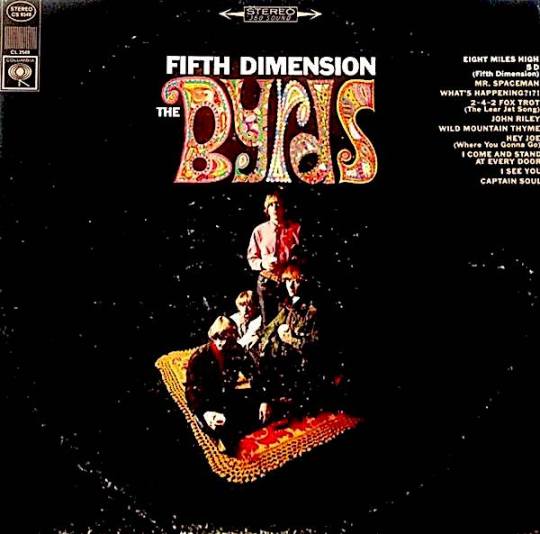
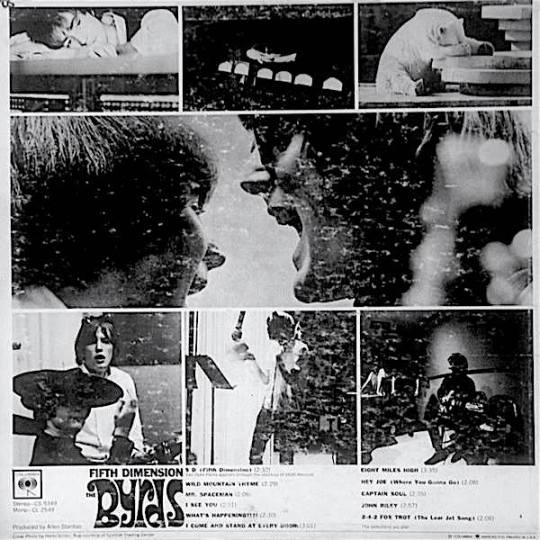
The Byrds - Fifth Dimension
The album Fifth Dimension took flight following two ground-breaking albums that had melded the innovative essentials of the British Invasion with the burgeoning folk-pop music scene happening in the U.S. With the release of their first album The Byrds blended those styles into what came to be known as folk-rock. Although they may not have been the only ones to do this, nor the actual first to produce it, they became the most influential artists to do so. With Fifth Dimension, things took a left turn straight into the stratosphere of psychedelia and toward Raga as well, plus a bit of a right turn toward country music. The album contained all that, although it was perhaps not so well executed as their first record.
In March 1966 the single Eight Miles High b/w Why was released for take off. It turned people, as the saying goes, on their ears. The band and their manager Jim Dickson recorded the two songs at RCA Studios in December 1965, and those songs were a creative leap for them. According to Columbia all recording had to take place at the label’s studios and, with their house producers. The re-recording took place in January. The bulk of the song was written by band member Gene Clark, who had become the band’s primary songwriter, but Roger (Jim) McGuinn and David Crosby were co-writers. By the time the song came out Clark had departed. The “official reason given for his departure was it was due to his fear of flying which prevented “him from fulfilling his obligations with the group”, according to Johnny Rogan in his book, The Byrds: Timeless Flight Revisited. The reality was that it also had something to do with general anxiety issues. Of course, there was that little affair with a certain “Mama” in another up and coming band as the year progressed.
The remaining quartet, McGuinn, Crosby, Chris Hillman and Michael Clarke were left to complete the album which was recorded over the next three months and released in July. The other single that was released, 5D (Fifth Dimension) b/w the instrumental, Captain Soul, came out one month before the album. The two singles were victims of being banned due to alleged drug references by certain stations and markets. This, in part at least, helped prevent them from going higher on the charts than they did. Eight Miles High, which topped out at No.14 on Billboard and 24 on UK Singles, was also cited for being comparably noncommercial and complex for the average listener. 5D (Fifth Dimension) was another, perhaps even more psychedelic track, that only reached 44 on Billboard and never charted in the U.K. The composer, Jim McGuinn, was being cerebral and metaphysical in his approach to the song, trying to explain Einstein’s theory of relativity while also citing Don Landis’ book 1-2-3-4 More, More, More, More as inspiration. Yet a large amount of the audience was interpreting the abstract lyrics as relating to an LSD trip. The other songs written by McGuinn for the album were also eclectic. Mr. Spaceman, which got some radio airplay in some areas, was definitely a lean into country music with by no means typical country style lyrics. 2-4-2 Fox Trot (The Lear Jet Song) was novelty song. The main characters of the song were a Lear jet and a pilot preparing to take off in it while the band sang a ten-word phrase repeatedly throughout the entire song. The next song on the album, I See You, co-written by McGuinn and David Crosby, has a jazzy feel and contains some effective 12-string guitar solos. What’s Happening!? is David Crosby’s lone solo composition on the album and presaged his hippie ethos rants to come. Crosby was also the catalyst for including his version of the garage rock song Hey Joe that The Leaves made into a Top 40 hit. The Leaves version came after hearing both The Byrds and Love play it at shows in the LA area. It is a song that is said to have been written by Billy Roberts. There are other claims to its’ authorship as well, but Roberts holds the copyright. Crosby brought it to the band in the first place and wanted to record it before they had gone into the studio. The rest of the band was not excited about it, but by the time they were in the Fifth Dimension session Crosby was was so angry because The Leaves already had a hit and Love had also recorded it, that they agreed to let him sing it on the album. Wild Mountain Thyme, credited as a traditional song, is more directly associated with the song adapted by Belfast musician Francis McPeake and first recorded by his family in the 1950s. The source was an Irish/Scottish folk song, the lyrics and melody being a variant of Robert Tannahill and Robert Archibald Smith’ The Braes of Balquhither. The McPeake basis of this was related to me by Belfast musician, and former band member with Van Morrison, Kevin Brennan, who had personally known the McPeakes. All four band members were responsible for the instrumental Captain Soul, and they are also credited for arranging the other traditional song on the album, John Riley, which is derived from Homer’s Odyssey and interpreted through 17th century English folk ballad tradition. It was recorded by Peter Seeger in 1950. I Come and Stand at Every Door is the closing song on the first side. It originated as a 1955 poem by Turkish poet Nâzım Hikmet (Ran), called Kız Çocuğu (The Girl Child). It was a plea for peace from a seven-year old girl who had died in the atomic bomb explosion in Hiroshima and has, of course, an anti-war message. The only composer in the album credits is Çocuğu, but he was only responsible for the Turkish poem he had written. The roots of the American song version emanate from a non-traditional melody composed by Jim Waters in 1954 to fit the lyrics of Child 113 ballad The Great Silkie of Sule Skerry. Pete Seeger describes the story behind his version of the song in his Where Have All the Flowers Gone: A Singer's Stories, Songs, Seeds, Robberies (A Musical Autobiography) (1993):: “Jeanette Turner did a loose English "singable translation" of the poem under a different title, I Come And Stand At Every Door, and sent a note to Seeger asking "Do you think you could make a tune for it?" in the late 1950s. After a week of trial and failure, this English translation was used by Seeger in 1962 with an adaptation of "an extraordinary melody put together by a Massachusetts Institute of Technology student James Waters, who had put a new tune to a mystical ballad The Great Silkie which he couldn't get out of his head, without permission." Seeger wrote in his Where Have All the Flowers Gone: A Singer's Stories, Songs, Seeds, Robberies (A Musical Autobiography) (1993), ”It was wrong of me. I should have gotten his permission. But it worked. The Byrds made a good recording of it, electric guitars and all.” Tom Clark, a poet who had a blog called Beyond the Pale, posted the poem with photos referencing Hiroshima and further discussion. Per his response further down in the comments 7 August 2015 at 03:32, “…… rest assured the credit situation had long since been settled up fair and square by the time Pete Seeger, at 90, did that amazing a capella version for Democracy Now. The song is now and forever copy(r)ighted c: Nazim Hikmet/James W. Waters.”
Eight Miles High was the last piece in the puzzle which determined if I was finally going to accept rock and roll as my musical lord and savior. Well at least one of my musical saviors anyway, jazz was already in my head. It came on the heals of music I was listening to in 1966 from the Animals, Outsiders, Young Rascals, Troggs, Syndicate of Sound, Kinks, Paul Revere & The Raiders and particularly The Yardbirds, with Shapes of Things. When I first heard Shapes of Things I knew I was hooked, and Eight Miles High confirmed it. Looking back, it appears I was wide open to the ideas of psychedelic music because both these songs have been identified as pioneers in that genre. My true turning point came when a classmate of mine and I were hanging out at school and he started asking me about my musical likes. This was not long after I had started hearing Eight Miles High on the radio and I finally admitted that I was getting hooked on rock music. I had that undeniable "gotta have it" experience going on, but I wasn't into buying 45s at that point and frankly thought it surely must be on an album. It turned out that album took an another four months from the single release to be issued. It felt like an eternity, especially since it still took me a few more months to finally buy Fifth Dimension. It is generally recognized that the Yardbirds’ song, with Jeff Beck’s Asian/Indian-Raga feedback-laden guitar solo, and the anti-war/pro-environmental lyrics, was the first popular psychedelic song. Eight Miles High, is likewise considered the first American popular psychedelic song, with The Byrds next single, 5D (Fifth Dimension), following up a few months later. What followed was a two to three-year period in which the new psychedelic music scene was explored from top to bottom, and sideways. Psychedelic music incorporated new playing techniques, use of unusual or unexpected instruments, new ideas in thought and expression. It most certainly was influenced by the growing use of drugs, particularly those labeled as psychedelics such as LSD. As was mentioned, both Eight Miles High and 5D failed to reach higher chart plateaus, at least at part, because of what was alleged to be drug references in the songs. Eight Miles High approximates the height at which jet airliners fly and was a reference to that experience. Latently both Roger McGuinn and David Crosby admitted that their own drug use had influenced their contributions to the song. McGuinn however, who wrote 5D (Fifth Dimension) as a reference to Einstein’s Theory of Relativity, was disappointed by much of the listening audience assuming it was about drugs. What did he expect? It was 1966 after all, and perhaps that’s what they wanted it to be. Despite the psychedelic feel and abstract lyrics of 5D, McQuinn still somehow managed to make it sound country as well. The album ended up being a continuation of the folk-rock sound that The Byrds had helped pioneer with their first two albums. It also found them exploring what came to be known as country-rock.
A notable difference between Fifth Dimension and The Byrds’ first albums is that the band had five original compositions with four by Bob Dylan in each of them while Fifth Dimension contained eight by The Byrds and none by Dylan. The reviews of the album have been mixed, with some, such as New Express Magazine calling it "faultless" and a work that "heralds a newly psychedelic Byrds hung up on the archetypal acid-fixation with the unknown”, while others were disparaging. The general direction of criticism of the album was that it fell below the standards set by their first two albums, that it lacked energy, that it was “wildly uneven” per Richie Unterberger, or as Barney Hoskins in Mojo put it, "can't quite decide what sort of album it is”. On the other hand Billboard Magazine, later called it “their most under-rated album”. I, for one, was quite happy to not be some jaded critic. My mind was being opened up by new music, new ideas, and I could not get enough. Since I hadn’t obtained the first two albums, Fifth Dimension became my compass point for the Byrds, even though I had heard and enjoyed their first two hit songs. Fifth Dimension, with its’ various styles, was perfect for me and I listened to it repeatedly for quite a long time. It still remains one of my favorite albums. I even found a way to enjoy 2-4-2 Foxtrot (The Lear Jet Song) when I finally listened to it from the perspective of someone sitting in the co-pilot seat. Must have been at LAX.
One cut on the album had a resounding affect on me, "I Come and Stand at Every Door". I was still developing my own perspective on what was going on in the world and this song helped me look at many things differently.
https://en.wikipedia.org/wiki/The_Byrds
https://en.wikipedia.org/wiki/Fifth_Dimension_(album)
https://www.allmusic.com/artist/the-byrds-mn0000631774/biography
https://www.allmusic.com/album/fifth-dimension-mw0000200612
https://www.britannica.com/topic/the-Byrds
https://www.discogs.com/artist/215471-The-Byrds
https://en.wikipedia.org/wiki/Wild_Mountain_Thyme
http://tomclarkblog.blogspot.com/2015/08/nazm-hikmet-ran-i-come-and-stand-at.html?m=1
Pete Seeger Aug. 9, 2013 https://www.youtube.com/watch?v=C9qzZ0-qkac
https://www.youtube.com/watch?v=o1ql_ADlWoY
LP15
0 notes
Text
Sanctuary: Chapter 25
Pairing: Wolfstar
Summary: The epic tale of Remus Lupin and Sirius Black, from their first meeting until their happily ever after.
Link to Prologue
Link to All Chapters
Link to story on AO3
Monday, 20th December 1971 Remus spent the last few days leading up to Christmas with Sirius having snowball fights in the grounds, exploring the castle, lazing about in the common room or their dorm and sneaking out at night to set-up the back to school surprises in the common rooms of all four houses.
They'd decided to tackle Hufflepuff first and arrived outside the barrel entrance at two o'clock in the morning. Remus reached out with his wand and, mimicking the boy from the previous afternoon, tapped the barrel. Tap tap rat-a-tap. The barrel opened, revealing an earthy passage that sloped gently upwards. He glanced at Sirius, who shrugged at him before leading the way inside.
He crept down the passage behind Sirius, and after a few seconds, it opened out into a bright, low-ceilinged and circular room filled with plant life. 'This is cosy,' Sirius whispered, looking around. 'I think this is my second favourite common-room. Gryffindor is first, obviously.' Remus was forced to agree. The room was decorated in yellow and black, with highly polished, honey-coloured furniture, and the doors to the dormitories were whimsically round. It was warm and inviting. He would enjoy spending time there, especially with all the plants. 'This bit of wall looks good. Get ready to cover me if you hear anyone coming.' He nodded and Sirius set to work painting a large mural of a badger wearing a Hufflepuff tie and hat and holding a quill in a meadow of wildflowers. The project took a full two hours, and he was beginning to get nervous that people might start getting up when Sirius finally stepped back to admire the finished work. 'Magnifique,' Sirius said, dramatically kissing his fingers. 'It's perfect,' he whispered. 'Now get out the way so I can hide it.' Sirius stepped back, and Remus waved his wand in a complex motion of swirls. 'Statuto tempus cabaturium,' he muttered. The mural vanished. It would reveal itself at half-past four on the first of January, just when everyone would be returning from the holidays. They had one more thing to do before they left. Using the flagrate charm, Remus wrote a message on the wall next to where the mural lay hidden before casting the concealment charm again to hide it from view.
We're the Marauders of Hogwarts
you thought we didn't care
but we broke in to show you otherwise
with just a touch of flair.
The following night they hit Ravenclaw tower. He easily solved the riddle on the door to gain entry, and Sirius painted a mural of an eagle soaring through a library wearing a Ravenclaw tie and hat. Remus wrote his message to Ravenclaw house and then hid both mural and message for later.
We're the Marauders of Hogwarts
and we're just as smart as you
we broke in here to prove it
and we left you with a view.
On Wednesday night, they were feeling a little tired, so decided to do their own house. Sirius painted his mural of a regal lion wearing a Gryffindor tie and hat, with a green and silver snake under its paw, and Remus once again added their note and hid both for later.
We're the Marauders of Hogwarts
and we broke in here to say
that Gryffindors are great
in every single way.
They didn't technically break-in to Gryffindor tower, but saying they did meant anyone from different houses who compared, still wouldn't know which house they were in. Although the "Gryffindors are great" part did give the game away a little. Slytherin was last, and they tackled them on Thursday night. Sirius had resolutely refused to paint a mural, even a mean one. So, instead, they set delayed transfiguration on the entire room to make everything inside turn a violent shade of pink at the allotted time. Remus wrote out the poem he'd written for the Slytherins before Sirius added an extra line at the bottom with a snigger.
We're the marauders of Hogwarts
you thought we wouldn't dare
but we broke through your defences
to redecorate your lair.
Suck it, Snape.
'Sirius!' Remus whisper-shouted. 'What?' Sirius asked, holding his hands up in defence. 'He might suspect us, but no one will believe him. He'll just make himself look crazy.' Sirius made a good point. No one would believe first years had pulled off the Halloween and Christmas displays. 'Alright, we'll leave it.' He cast the concealment charm, and they snuck back to Gryffindor Tower to get some much-needed sleep.
-o-o-o-o-
When Sirius woke up on Christmas day, it was still dark outside the window and Remus was sleeping peacefully. Perfect. He needed to sneak down to the owlery and wait for a special delivery.
He slipped out of bed, grabbed the clothes he'd put ready the night before and padded to the bathroom to dress. When he was ready, he snuck out of the dorm, shutting the door quietly behind him, and ran down the stairs to the portrait hole. It took him ten minutes to reach the ground floor and another ten to get to the owlery. Once there, he rubbed his arms against the cold and paced impatiently, waiting for the owl to arrive with Remus' Christmas present. Twenty minutes later, a large brown barn owl swept through the window carrying a box with holes in the top. He paid the owl and carried the box carefully back to the dormitory, before tucking it under his bed. Hopefully, it would stay quiet until he was ready to give it to him. Sirius glanced at Remus' sleeping figure under the covers. It was seven o'clock. Why was he still sleeping at seven o'clock on Christmas day? He tiptoed over to the bed, leant over Remus and-- 'Arghh!' Remus yelled. Sirius yelped and jumped backwards, almost falling over, and Remus cracked up laughing. 'Merlin, your face!' Remus said in between giggles. 'You scared the crap out of me.' He clutched his hand to his chest above his heart, which was racing. 'Nice one! How long were you awake?' 'Since before you came in the room. Where did you go?' Remus asked, sitting up in bed. Sirius scratched the back of his head. He was caught. There was no point lying about it. 'I went to receive a delivery. It's your Christmas present, actually.' 'Oh. Okay, did you want to do presents now? Or wait until after breakfast?' He gaped at Remus. 'Wait until after breakfast? Are you mad? Presents!' 'Well, that's what I was hoping you'd say, but it's polite to ask,' Remus said, smiling. 'Shall we open the ones from James and Peter first?' Sirius asked, grabbing a small square package and a long oblong one from the small pile at the end of his bed. Remus crawled to the end of his bed and found two similar packages in his own pile. 'Sure. Your bed or mine?' He walked over to him. 'I'm already up so let's sit on your bed.' They ripped the paper off of the small square boxes from Peter at the same time, and they each had a mega-box of Bertie Bott's Every Flavour Beans. Sirius immediately ripped his open and started examining a small white one. 'What do you reckon? Vanilla?' Remus peered at it. 'Could be.' He popped it in his mouth, chewed it with a grimace, swallowed, and said, 'I think it was toilet paper.' Remus shook his head, chuckling, and picked up the parcel from James. 'Ready?' They ripped the paper off of James' presents and each pulled out a fancy red dragon skin wand-holster with gold detailing. There was a note inside the parcel that read: A Marauder should always have easy access to their wand. 'Wow, this is amazing,' Sirius said, putting it on and placing his wand in it. He practised drawing his wand at speed. The action was smooth and clean, so much easier than fumbling to grab it from a pocket. 'Try yours.' 'I'll try it out once I'm dressed,' Remus said with a chuckle. 'Spoilsport,' he said, pouting at him, but he sat back down on the bed. 'Okay, you open mine now.' He handed Remus a small wrapped box and watched closely, eager to see his reaction. Remus took the present, looked at it, glanced at Sirius' bed, shrugged and pulled the paper off. Inside was a silver pendant strung on a black leather cord. The pendant was shaped like a shield with a stylised M in relief on its face. Surrounding the M were four symbols; a paintbrush and a broomstick crossed behind the M, and a book and a cauldron sat in front of it on either side. Remus examined it thoroughly before looking up at him. 'Did you make this?' He shrugged. 'I drew it and sent the design to a jeweller. I bought one for each of us. It's the Marauder's crest.' Reaching into the neck of his robes, he pulled out his own identical silver pendant. 'It's brilliant. Thank you,' Remus said. He put the pendant on and looked at it again with the corners of his mouth twitching up in a suppressed smile before tucking it inside his pyjama top and handing Sirius his present. Sirius took the package, wishing he knew what Remus was thinking, and tore the paper off. The glass ball inside fell into his hand and he stared at it. It was the perfect size to fit comfortably in his hand, and the glass was smooth and crystal clear. He glanced up at Remus. 'What is it?' 'I call it a snitch-o-scope. I transfigured the balls from the sand in the beach room and added charms to detect people nearby. Anyone that isn't the four of us.' 'What does it do if it detects someone?' he asked, giving the ball an experimental shake. Nothing happened. 'It glows red if it's an adult, or orange if they're underage.' Sirius felt his mouth stretch in a grin. Knowing if anyone was nearby would make sneaking around so much easier. 'This is brilliant. You always give the best presents. Thank you.' Remus smiled and a faint blush bloomed on his cheeks. 'You're welcome.' Okay. It was time for Remus' other present. 'I got you something else too.' 'What, why?' Remus asked, frowning at him and causing a crease to appear between his eyebrows. Sirius had the insane urge to reach out and smooth it, which he heroically resisted with great effort on his part. 'I thought of it after you told me about how alone you are at home.' That was an outright lie; he'd thought about it when he read the werewolf books, but Remus didn't need to know that. 'Okay?' Remus said. Sirius jumped up and fetched the box from under his bed, handing it to Remus before sitting back down on the bed to watch his reaction. Remus eyed the holes in the top of the box nervously and glanced back up. 'Is there something alive in there?' He grinned and nodded. 'It won't hurt you. I wouldn't give you a dangerous Christmas present.' Remus raised an eyebrow. 'I wouldn't put it past you.' Sirius barked out a laugh, and a tiny whimper came from inside the box. 'Oops, I think I scared it.' He waved his hands in a hurry-up motion. 'Open it.' Remus pulled back the flaps on the box and peeked inside. 'Awww.' He reached in and lifted out a tiny jet-black kitten. It was mewling softly. Remus settled the kitten in his lap and scratched its ears. 'You bought me a kitten?' He shrugged. 'Yeah. I thought it could keep you company. You know, at home?' And on the full moons, he finished in his head. Remus picked the kitten up and looked at its belly. 'Thank you, Sirius. I love her.' 'What are you going to call her?' Remus frowned. 'I'm not sure. I'll have to think about it.' He paused. 'I hope she gets on okay with Rieka.' He hadn't thought about that, cats and birds weren't traditionally friends. 'I'm sure it'll be fine.' He hoped it would be fine. If the cat ate the owl, he wasn't sure Remus would forgive him. They finished opening the rest of their presents. Remus had a new book series from his mum, and Sirius got a fancy set of quills from his Uncle Alphard and a letter he would read later. Once Remus had dressed and put on his new wand holster, they went down to breakfast.
-o-o-o-o-
Christmas breakfast at Hogwarts was a feast. Every single type of breakfast food you could think of was made available. Remus couldn't help but wonder what they did with the leftovers. The amount of food in this one meal would probably feed his family for two years.
They left the hall with full bellies. His new kitten had been alone in the dorm for a long time, and he may have been walking a little faster than he normally would. 'Would you slow down a bit?' Sirius asked from a few steps behind. 'I ate far too much, and I can't move that fast right now.' 'I'm worried about the kitten. She's been all alone up there for ages. What if she's scared?' Sirius chuckled. 'It's a cat, Remus. She's probably curled up on your bed fast asleep.' Sirius was proven right when they arrived at the dorm. The kitten was indeed, curled up in a black fluffy ball fast asleep. But there was something else on the bed next to her. A tightly rolled scroll, sealed with red wax. 'What's that? Has someone been in here?' Sirius asked. Remus sighed. 'I know as much as you do, Sirius.' Sirius glanced at him. 'Should we open it?' 'That's what you would usually do with mail, yes?' 'There's no need to be a smart arse. There's a mysterious letter on your bed, and you're acting like this is an everyday occurrence for you. Is this an everyday occurrence for you?' He rolled his eyes. 'No, Sirius. I can't say I've ever received a mysterious letter before. But if we don't look at it, it'll remain mysterious forever.' They stared at each other for a moment longer, before Sirius snorted and bounded over to the bed, grabbing the scroll. He broke the seal and unrolled it. 'It's addressed to The Marauders.' 'Who's it from?' he asked, joining Sirius by the bed and trying to see over his shoulder. An almost impossible feat as Sirius was a full head taller than him. 'Dumbledore?' 'No. It says it's from the Hogwarts Chiefs of Raucous Revelry,' Sirius said. 'Really? What does it say?' Sirius handed him the scroll. 'Read it.'
The Hogwarts Marauders, We have been watching you since you arrived at school and have been most impressed with your penchant for mischief and your ability to maintain a secret identity. Your large-scale events at the Halloween and Christmas feasts were remarkable, and your discovery of the beach room showed great promise for your future as mischief-makers. We have enjoyed six and a half wonderful years in charge of entertainment here at Hogwarts, but alas, it will soon be time for us to leave these hallowed halls and join the world. And so we must pass our legacy on to the next generation. Yes, you have guessed correctly. We have chosen the four of you to continue in our footsteps, bringing joy and wonder to the students of Hogwarts. But first, you must prove yourselves worthy. We have devised an elaborate challenge to test your determination, perseverance, skill and daring. You have until the 16th of June to complete the task and earn your reward: our legacy. On the sixth floor, there is a door that cannot be opened. Behind that door is a flag. When you retrieve the flag, you will attach it to the top of the astronomy tower. This will be the signal to us that you have completed the task. The only way to gain access to the room is by drinking a potion called Spectral Essence. We will provide one small piece of assistance in this task. The word "Dissendium" is of great importance on the third floor. Merry Christmas and good luck. Yours in mutual mischief, The Hogwarts Chiefs of Raucous Revelry.
He looked up from the scroll and stared at Sirius, feeling a little dumbstruck. Sirius just nodded. 'I know.' 'James is going to be unbearable when he reads this.' Sirius nodded again. 'I know.' 'He's going to hound us non-stop until we've completed the challenge.' Sirius nodded a third time. 'I know. Stop pointing out the obvious.' 'Right.' He sat down on the bed and picked up the kitten, placing her in his lap where she nuzzled his fingers. 'We could hide it, and never ever tell him?' he asked hopefully. 'If he found out, he'd never speak to us again.' He slumped. 'That's true. We're going to have to do it, aren't we?' 'Don't you want to?' Sirius asked, sitting down next to him. He grinned. 'Of course! I just don't want to put up with James' ego about it.' 'I know, but we can just tell him to shut up if it gets too much.' Sirius took the scroll and looked at it again. 'Do you want to investigate the third floor?' 'I think James will be mad if we start without him.' Sirius rolled his eyes. 'Yeah, you're probably right. Think we should tell him about it in a letter? We can be really cryptic, and he won't be able to stop thinking about it for the rest of the holiday.' 'Drive him crazy before he drives us crazy?' he asked with a chuckle. 'I think that's the best idea you've ever had.' They spent the rest of the day in their dorm writing to James and Peter to thank them for their presents and tell them cryptically about the letter, playing with his kitten which he named Cosmo, and setting up a back to school surprise in James' and Peter's beds, a task which included a lot of giggling. The feast mid-afternoon was every bit as spectacular as breakfast had been. The house-elves really went all out at Christmas, and the wizarding crackers were a good laugh. Sirius got a pirate hat which Remus thought suited him, and he got a muggle top-hat in a vivid shade of purple which Sirius forced him to wear for the rest of the day. The next three days of the holiday passed much like the first half, but with less excitement. They explored the castle some more. Having finished with the seventh floor, they had moved on to the sixth but had yet to find a door that wouldn't open. They tested out Sirius' snitch-o-scope, and it worked beautifully, silently alerting them to any human presence within twenty feet of their location. By Wednesday, though, he was beginning to feel the effects of the moon and wanted to slow down. He'd expected some resistance from Sirius to the idea of staying in the common room, but he seemed oddly understanding of his desire for rest, and they sat by the fire together with Cosmo curled up between them and did nothing much at all. It was nice. 'Hey,' Sirius said, breaking the companionable silence. 'Do you remember that lesson on boggarts? You weren't talking to us at the time.' He shuddered. How could he forget? The sight of his mum's bloodied corpse had haunted his dreams for weeks. 'Yes.' 'During that class, James said, after we graduate, he wants us all to move in together. Would you be up for that?' He glanced at Sirius. 'Are you sure I was included? Like you said, we weren't friends then.' Sirius nodded. 'Yes, he specifically said, "Remus too, if he ever talks to us again." Say you will, it'll be awesome.' Remus felt warmth flood his chest. James had included him even though they weren't talking at the time? The warmth soon disappeared though, to be replaced with a heavy weight and an ache in the back of his throat. He doubted they'd want a werewolf living with them, but he couldn't explain that, so he just nodded. 'Sure, sounds great.' 'Excellent,' Sirius said. 'It wouldn't have been the same without you.'
-o-o-o-o-
Letters sent after Christmas
Saturday, 25th December To James, Remus and I thank you for our beautiful wand-holsters. What a perfect present for a team of mischief-makers. Something very exciting happened today that we think you'll be delighted to hear about. Unfortunately, it is sensitive information, and we can't possibly tell you about it in a letter. So you will have to wait until you return to hear the specifics. Can't wait to see you, Sirius, Remus and Cosmo Saturday, 25th December To Peter, Sirius and I thank you for the sweets. We're being very careful about which ones we eat, but if I dare Sirius to eat them, he does, and he pulls very amusing faces. It's a lot of fun. Something very exciting happened today that we think you'll be delighted to hear about. Unfortunately, it is sensitive information, and we can't possibly tell you about it in a letter. So you will have to wait until you return to hear the specifics. Can't wait to see you, Sirius, Remus and Cosmo Saturday, 25th December To Sirius and Remus, Sirius, I love the pendant. I can't believe I didn't think about us needing an official Marauders crest. I'm going to wear it all the time. Did you get one for everyone? Remus, I have no idea what this globe thing is, but it keeps lighting up red. Is that bad? Only a week until I come back! James Saturday, 25th December To Sirius and Remus, Remus, what is this globe? It keeps flashing red and orange, and I'm worried. Sirius, thank you for my pendant. Did you get one for all of us? I really like it. Peter P.S. I can't write anymore. My muggle relatives are getting freaked out by all the owls. Saturday, 25th December To James, Thank you for the wand holster. This is the coolest thing I've ever owned. I hope you liked your sweets. Peter P.S. I can't write anymore. My muggle relatives are getting freaked out by all the owls. Saturday, 25th December To Peter, Thank you for the sweets. I kept all the yucky ones, melted them down and put them in my dad's coffee. It was so funny. James Sunday, 26th December To Sirius and Remus, First, who is Cosmo? Are they a new Marauder? Why was I not consulted? Second, tell me, tell me, tell me! James P.S. You're welcome. I hope you're both wearing them all the time. A Marauder must always be prepared. Sunday. 26th December To Peter, You're welcome. I'm glad you like it. I think you know by now how much I "enjoyed" the sweets. Have you heard from Sirius and Remus? Did they tell you about this exciting thing that happened on Christmas day? They won't tell me anything. Also, do you know who Cosmo is? James Monday, 27th December To James, Cosmo is the newest Marauder. She arrived on Christmas day, and her special talents include dozing in the sun and finger nuzzling. You were not consulted because you were not here. The globe is my own invention; I call it a snitch-o-scope. It lights up if people are nearby (except for us), red for adults, orange for children. Remus, Sirius and Cosmo P.S. We are both wearing our wand holsters at all times except when sleeping. Tuesday, 28th December To Remus, Sirius and Cosmo (Apparently), We have Remus for sun dozing, and Sirius for finger nuzzling. Why do we need Cosmo? I don't believe absence is a good enough reason for not being consulted. The snitch-o-scope is brilliant! It's going to be so useful. You still didn't tell me. Is it Cosmo? Is that the exciting thing? Waiting eagerly, James Wednesday, 29th December To James, I do not finger nuzzle! But you're right about Remus dozing in the sun. Alas, there is not much sun to be had in Hogwarts today, so Remus is dozing on the sofa in the common room in front of the fire instead. Cosmo is curled up with him, and I am all alone but standing guard. Cosmo is not the exciting thing. We cannot talk about the exciting thing in writing in case these letters are intercepted. Sirius (and a sleeping Remus & Cosmo) Thursday, 30th December Sirius and (a hopefully now awake) Remus and Cosmo, I was very confused by your description of Remus' and Cosmo's sleeping arrangements, but I am now starting to suspect that Cosmo is an animal of some sort. I'm in two minds about your refusal to tell me by letter about the exciting thing. I like your caution, but I hate that I have to wait. Only two more days, James
Chapter 26
0 notes
Text
Mary I, Queen of England (1516-1558)
Mary Tudor, the first Queen Regnant of England. Only surviving child of king Henry VIII and his first Queen Consort Catalina De Aragon was later to rest today in Westminster Abbey.
She lived a hard life as she and her mother were rejected by her father for Anne Boleyn. Henry believes a woman could never rule England. Sexism and attitude of his time!
She lost her mother when she was 19 years old and had not been permitted to see her since 1532 when Catalina was sent away from court. Catalina died on the 7th of January 1536 at the age of 50. She was surrounded by her ladies in Kimbleton Castle.
This is the event that changed Mary forever. She grieved for her mother for the rest of her life.
With the death of Edward VI her younger half brother on the 6th of July 1553 Mary declared herself Queen of England according to the last will of her father. Edward however named his protestant cousin lady Jane Dudley (nee Grey) as his successor. She was only 16 years old. She was demposed on the 19th of July 1554 and locked in the tower of London. Mary seized the throne.
Mary married her Spanish cousin Philip II of Spain. In her final years she suffered two false pregnancies which crushed her and harmed her marriage. She could not give het husband a son to rule England and/or Spain.
She met her end on the 17th of November 1558 in her home in St.James Palace, London. It is thought that she died due to Uterine Cancer or Ovarian Cysts.
With Mary's death the way to Elizabeth her half sister to assend to the throne. Elizabeth buried her sister as a Queen in Westminster Abbey against her will to be buried next to her ill fated mother Catalina De Aragon.
Although her reign was brief she did have many achievements that were overshadowed by those of her younger sister's. She established the nqvu which hadn't been suitable since the death of her father eleven years before hand. She established the Catholic church as the religion of England. Many opposed this but many rejoiced.
Mary is known as Bloody Mary. She was asked by the Pope to execute the Protestants in England. In reality, She only executed a total if 1'700 people. Her father Henry VIII executed approximately 72,000 people but he was known as Henry the Great! In my opinion that man was a total wreck from the experiences in his life. Losing his brother and his mother at such a young age would have traumatized him. Then the countless stillbirths and the death of his beloved Prince Henry the New Years Prince.
This is an extract from The Tudors: Facts vs Fiction on Facebook.
14 December 1558: Queen Mary I was finally laid to rest on Westminster Abbey. Her beloved cousin, Margaret Douglas, Countess of Lennox, acted as chief mourner. A funerary Mass was held for her, headed by the Bishop of Winchester, John White, who incurred the wrath of her sister after he made an insinuation against her, and added that he wished her a "prosperous reign" if "God wills it". Furthermore, he had been in hot water before when he created a beautiful eulogy for Queen Mary which Elizabeth disagreed because it made no mention of her. The poem went as follows:
“How many noble men restored
and other states also
Well showed her princely liberal heart
which gave both friend and foe.
As princely was her birth, so princely was her life:
Constant, courtise, modest and mild;
a chaste and chosen wife.
Oh mirror of all womanhood!
Oh Queen of virtues pure!
Oh Constant Marie! Filled with grace,
No age can thee obscure.”
And then the following lines were added:
“Marie now dead, Elizabeth lives,
our just and lawful Queen
In whom her sister’s virtues rare,
abundantly are seen.
Obey our Queen as we are bound,
pray God her to preserve
And send her grace life long and fruit,
and subjects truth to serve.”
The day after the funeral he was placed under house arrest.
Mary I's wishes to be buried next to her mother were not met, neither were the ones of her mother moved to the Abbey. In 1603 after Elizabeth's death and James VI ascended to the throne, he built a great monument for her and placed her tomb on top of Mary's. Although the monument is beautiful and everyone who has the opportunity to visit the Abbey any time soon or lives nearby, should see it; it lacked Mary's effigy. The monument was a huge homage to the Virgin Queen but Mary is nowhere to be seen. The plaque at the bottom reads: "Partners both in throne and grave. Here rest we, two sisters, Elizabeth and Mary, in the hopes of the resurrection."
Perhaps as one of my favorite songs ("So long goodbye" by 10 years) says 'may we meet again in another life like strangers passing by'. May the two rest in peace.
Sources: Tudor: Fact vs Fiction, (Facebook Page)
The six wives of Henry VIII I'm afraid I am notnsure if the names of the historians in this documentary. I apologize.
David Starkey series Mary I - Bloody Mary
10 notes
·
View notes
Text
Hallo lovely Humans!
And February is done! leap years are weird man, i keep thinking of people born on leap year, how do they celebrate their birthdays?
So here’s how February went
Reading:
Illuminae by Jay Kristoff and Amie Kaufman [ Audio-book and Physical copy]: i started this in January I finished this the first week of Feb. okay i understand the hype, i got the audio book for Geminae and obsidio so i will be reading that sometime this year
Shiver by Ella Frank And Brooke Blaine[E-book]: i don’t know how i feel about this, it was supposed to be dark but i just found it meh. i will still read more from these authors though, they are one of my favourite writing duo’s.
Questions for Ada by Ijeoma Umebinyuo [E-book]: Loved this collection of poems,
Neighborly by Katrina Jackson [E-book]: OO lordy this is a smexy read, A+ smut highly recommend ( for +18 obvs )
The Circle (Omega Academy#2) by Lily Archer [E-book]: I wrote a review of this already and i hope you actually pick up this series its super interesting!
Finding Finely by Riley Hart [E-book]: this was a slow one i dropped it and then because i was curious i picked it up to finish it, it was okay just tiring and a bit repetitive for me (18+ with BDSM)
Snug: A collection of comics about dating your best friend by Catana Chetwynd: The cutest book ever. If you follow Catana’s comic on instgram be sure to check this one out.
The Empress of Salt and fortune by Nghi Vo [E-Arc]: This book is small but mighty and it has an Enby character. My review would be up this month but i am telling you people to preorder this one, this one is for women.
And Then there were none by Agatha Christie [E-book]: I love mystery books even though i don’t read them all the time ( which i should). The quickest way to getting me to add a book to my tbr is a whodunit mystery. I love the tension, the guessing and oh shit i did not see that coming moments. And this book had all of those, it was so good! I highly recommend this and its available of KU.
#gallery-0-9 { margin: auto; } #gallery-0-9 .gallery-item { float: left; margin-top: 10px; text-align: center; width: 33%; } #gallery-0-9 img { border: 2px solid #cfcfcf; } #gallery-0-9 .gallery-caption { margin-left: 0; } /* see gallery_shortcode() in wp-includes/media.php */
Music
Asking Alexandria : The Violence and They don’t want what we want
Saint PHNX: Scream
In This Moment: In-between and Black Wedding
Falling in reverse: popular monster, Drug in me is you Re-imagined
Highest in the room by Travis Scott
NF: The search album
Strawhatz: Ching and Ching (revisited)
Nefex: Backstage
Book Hauls
[ Physical copies ordered between December- January and arrived in February]
The Gilded Wolves by Roshani Chokshi [physical copy]
The house of The Spirits by Isabel Allende [physical copy]
Earthsea Quartet by Ursula Le Guin [physical copy]
The Ghost Bride by Yanghze Choo [physical copy]
Tikka Chance on me by Suleika Snyder [E-book]
Empire of sand by Tasha Suri [E-book]
Just one more: A valentine day by Jodie Slaughter [E-book]
#gallery-0-10 { margin: auto; } #gallery-0-10 .gallery-item { float: left; margin-top: 10px; text-align: center; width: 33%; } #gallery-0-10 img { border: 2px solid #cfcfcf; } #gallery-0-10 .gallery-caption { margin-left: 0; } /* see gallery_shortcode() in wp-includes/media.php */
Mental health:
This month was okay, i had a heart to heart talk with my mum about me going trying out therapy this year for the first time and it was refreshing. Reading Questions for Ada was eye opening for me because i realized that i am hard on myself for not being were i want to be and for mistakes i made in the past. I decided i am going to learn how to be soft.
Favourite Quote:
I think i want to look into more of Maya’s work because there’s a lot i can learn from this great woman.
I will not be doing a tbr post this month until i complete the ones from last month ( Ha!)
And that’s all folks!
Thank you for stopping by, please take a minute to tell me how February was for you in the comments!
As Always,
Nelo- Booked Unicorn
February Wrap-up: February was great time to kick March's bottom. #bookblogger #bookblogger #booktwitter Hallo lovely Humans! And February is done! leap years are weird man, i keep thinking of people born on leap year, how do they celebrate their birthdays?
0 notes
Text
Antonio Brown timeline
The rise, fall, rise, and fall of Antonio Brown rivals any roller coaster you’ve ever been on.
Um… what?
That’s the question undoubtedly in the forefront of many minds as it relates to Antonio Brown, a wide receiver who was heralded as the best in the National Football League not so long ago. While no one can question his legendary talent, even in the midst of a maelstrom of negative headlines, the fact is Brown’s stock has taken more hits in these last few months than a Deontay Wilder opponent. His story as a professional football player once read as inspiring and was used by coaches and parents around the country to motivate players into never giving up.
After all, Brown bucked the odds and made it out of the Miami urbanscape — where he was born and raised going on to become a star receiver at Central Michigan. From there, he was forced to again prove himself after being selected with the No. 195 overall pick — the 22nd of 27 wide receivers in his draft class by the Pittsburgh Steelers, and was viewed by many as undersized at the position. He’d buck the odds yet again, though, going on to dominate at the NFL level. Brown delivered an eye-popping 8,210 receiving yards and 50 touchdowns from 2011 through 2016. He landed a four-year, $68 million in February 2017 for his efforts.
He’d go on to add another 1,533 receiving yards and nine touchdowns to his resume in 2017, but the air around him that once smelled fragrant was rapidly souring deteriorating to the point where the usually forgiving and player-centric Steelers began to notice a tinge of mustard gas. Fast forward a bit to the 2018 season, and despite hitting the 10,000-yard mark for his career, headlines surrounding Brown were about anything but that achievement. It’s now August 2019 and Brown’s NFL legacy currently reads as the polar opposite of the once inspirational story it was, but more like a cautionary tale for all who would heed it.
In looking at the timeline, which includes noting the rapidity of his character’s de-evolution, it’s enough to make even the most bombastic NFL players past, present, and future blush with an awkward level of discomfort.
January 2017 – The Facebook Live debacle
It was supposed to be a grand time in the city of Pittsburgh after Brown caught six passes for 108 yards to help push the Steelers past the Kansas City Chiefs in the AFC Divisional Round in an 18-16 nailbiter. Instead, the story became what happened next in the locker room following the win. Brown pulled out his phone and live-streamed the locker room celebration on Facebook in violation of league policy. This was also done in spite of quarterback Ben Roethlisberger asking Brown to lay low a bit on social media, and his decision to do the opposite shone a light on head coach Mike Tomlin hurling at least one sharp expletive around about the next opponent to come the New England Patriots in the AFC Conference Championship for which he issued a formal apology via press conference.
Late January 2017 – Everything’s ‘fine’
Just one week later, the Steelers took action. Brown was reportedly fined $10,000 by the team for streaming Pittsburgh’s locker room celebration, as first reported by Jay Glazer. Tomlin informed his players during a team meeting this week that he was fining Brown. Tomlin disciplined Brown, but the matter was made worse when it was discovered Facebook had paid Brown $244,000 at the start of the 2017 season to create content for them. And so, his fall from grace in Pittsburgh began.
It started with a slow boil at first, though, with the subsequent 2017 season being mostly “quiet” aside from Brown battling injury.
December 2018 – We talkin’ about practice?
Not yet eliminated from playoff contention and still in the running for the AFC North crown heading into their Week 16 battle with the New Orleans Saints, the Steelers had defeated the rival Patriots one week prior and felt good about finishing the season strong and carrying momentum into the postseason. The perennial Pro Bowler would go on to torch the Saints for 185 yards and two TDs on 14 receptions, but the next few days saw a displeased and apathetic Brown roaming the halls.
A heated dispute with a Roethlisberger during a Wednesday walkthrough escalated to the point where Brown threw a football at the QB, and the wideout opted to then skip the remaining practices leading up to the team’s Week 17 battle with the Cincinnati Bengals.
Brown was benched for that game, and while the official team stance was injury-related, the reality could neither have been further from the truth nor hidden anymore from the public eye. The reign of Brown in Pittsburgh was at an end, and the final chapter with the organization was messy. The world would never see Brown in a Steelers’ jersey again, and teammates would later reveal the end had been years in the making.
February 2019 – The anti-Valentine
Two days ahead of February 14, Brown took to his beloved social media accounts to both thank the Steelers’ fandom and proclaimed it was time to “move on“. It’s a sentiment the organization itself mirrored to a degree but still had enough motivation to attempt a repair in the relationship. After all, Brown was still under contract for three more years and coming off of a 1,297-yard season, but the damage had already been done and no amount of Fix-A-Flat was going to reinflate that tire. The sidewall was completely shredded and the Steelers finally admitted it to themselves and everyone else.
March 2019 – For whom the Bell tolls
The Brown decision was a difficult call made that much more challenging by the holdout of All-Pro running back Le’Veon Bell, whom the team was also locked in a battle with. Ultimately, they opted to not place a transition tag on Bell allowing him to walk in free agency followed by swallowing their pride and beginning the task of looking for trade suitors for Brown.
It was the end of an era in the Steel City.
March 2019 – Trader Joe
As bold and braggadocios as ever, Brown made it clear he was fine never suiting up again for the Steelers. It was essentially, as he went on to describe it, his way or the highway.
“I don’t even have to play football if I don’t want,” he told Jeff Darlington of ESPN. “I don’t even need the game. I don’t need to prove anything to anyone. If they wanna play, they going to play by my rules. If not, I don’t need to play. Obviously, I want the game, but I don’t need the game. It’s a difference.”
That’s not exactly the level of commitment to the sport potential trade suitors want to hear, but the ability of Brown was just too good to ignore for some clubs. With the Tennessee Titans, Washington Redskins and Oakland Raiders all entertaining a possible trade for the mercurial wideout, it was the latter who emerged as frontrunner behind the scenes albeit it with reservations of their own. The problem in Oakland was they had sent Amari Cooper to the Dallas Cowboys in Week 8 via trade and needed to secure a new No. 1 receiver. It also helped that head coach Jon Gruden was lathering at the mouth just thinking about what Brown could do for quarterback Derek Carr and an offense that ranked near the bottom of the league in passing during the 2018 season.
“[Brown] can run every route you dream up,” Gruden said in December preceding free agency. “I say that about other receivers, but he can run double move. He can run by you. He can run crossing routes.
“He’s very good after the catch. What’s the greatest thing about this man, I’ve told all of our receivers, if you get a chance to watch him practice, you’ll see what unlocks the greatness in him. He’s the hardest-working man, I think, in football. Hardest-working player I’ve ever seen practice.
“I’ve seen Jerry Rice. I’ve seen a lot of good ones. But I put Antonio Brown at the top. If there are any young wideouts out there, I’d go watch him practice. You figure out yourself why he’s such a good player.”
Some of those words would come back to haunt Gruden in ways he had never even dreamed of.
March 2019 – What can Brown do for you?
And so it went, however, the Raiders sent a 2019 third- and a fifth-round pick to the Steelers in exchange for Brown only days after his questionable football commitment comments, and what should’ve been a fresh start rapidly become a bag of rotten fruit.
Brown had three years and about $39 million remaining on the massive contract extension he signed with the Steelers back in 2017. However, the star wide receiver had his eyes set on more. Trading for Brown meant restructuring his contract and adding more money to it the Raiders knew that before acquiring him. Shortly after the trade, Brown negotiated a new deal with Oakland that will pay him $50.13 million over the next three seasons. This deal included another $30.13 million in guaranteed money.
May 2019 – The Hell-met
With the start of OTAs came a wind of change for Oakland, a team that finished 4-12 after awarding Gruden a 10-year, $100 million contracts to climb down out of the ESPN Monday Night Football booth and return to their organization after a near-decade-long hiatus from the game. Gruden and owner Mark Davis then convinced Mike Mayock to leave broadcasting to join them as new General Manager, and the organization felt things had rapidly begun to come together. In actuality, nothing could be further from the truth, and for one key reason:
Brown didn’t like his helmet.
In what has become a story pulled right out of the most twisted Edgar Allen Poe poem, Brown was so irate about the NFL’s new policy that would essentially decertify his longtime helmet and force him into a new one that he clashed openly with coaches at OTAs over the issue. This included him reportedly storming out of practice and attempting to sneak his old helmet onto the field, going so far as trying to paint it to mirror the mandated helmets in the hopes no one would notice.
Spoiler alert: They noticed, and it didn’t end well.
Following several exchanges over the issue, the team broke for summer break and believed HelmetGate was behind them going into training camp.
Late July/Early August 2019 – Frozen
The Raiders were wrong yet again about the mindset of Brown, because he was not done trying to take the field with his old helmet, and again he clashed with the coaches over it. This hadn’t been made public just yet, though, and mostly because there was an even more bewildering headline that emerged with the newly-acquired … well… a headache.
The team placed Brown on the Non-Football Injury list with a non-disclosed issue to start training camp, but they removed him immediately thereafter. Questions emerged surrounding the nature of Brown’s injury, and the truth turned out to be stranger than fiction.
The bottom of his feet was severely frostbitten after he entered a cryotherapy machine wearing improper footwear and he was sent to a foot specialist to determine the extent of the damage. Initially listed as day-to-day, Brown’s absence has since changed to what can only be described as indefinite, with conflicting reports now swirling about that claim he’s ghosted the Raiders and their attempts to communicate with him with an alternate report claiming there have been discussions and he’s expected to return “soon”. He took to IG to post a stomach-turning image of the soles of his feet, revealing just how bad they looked.
The [additional] problem is it doesn’t truly matter at the moment when his feet heal because it’s rumored Brown threatened to never play football at all for the Raiders if he isn’t allowed to wear his old helmet. The Raiders have financial recourse if Brown holds true to his threat with an arbitration hearing set to take place after he filed a grievance against the NFL but nothing could’ve prepared the Raiders for this circus of events.
This, of course, harkens back to March when he made it clear he doesn’t need football, and while the Raiders chose to ignore that likely assuming it was simply angst hurled toward the Steelers they’re finding out it’s simply how he feels.
At the end of the day, it’s Brown’s way or the highway.
“I’m really not into dreams anymore, okay? I’m into f—– nightmares,” Gruden famously said on the latest season of HBO’s Hard Knocks, speaking on how important the Super Bowl is. “You gotta end somebody’s dream.”
Unfortunately for him, his own All-Pro receiver might be the one that ends his, and before the two could even roll out of bed.
by Patrik Walker
The post Antonio Brown timeline appeared first on Smile store.
source https://smilystore.com/2019/08/10/antonio-brown-timeline/
0 notes